Cellon Communications Technology CT9A9M GSM/GPRS Mobile Phone with Bluetooth User Manual 9 9m CTA ZHS
Cellon Communications Technology (Shenzhen) Co.,Ltd. GSM/GPRS Mobile Phone with Bluetooth 9 9m CTA ZHS
User Manual
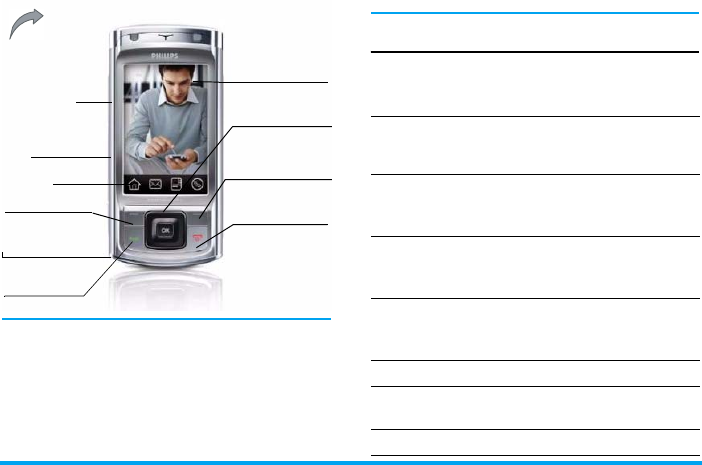
Discover your phone
Philips continuously strives to improve its products.
Therefore, Philips reserves the rights to revise this
user guide or withdraw it at any time without prior
notice. Philips provides this user guide "as is" and
does not accept, except as required by the applicable
law, liability for any error, omission or discrepancy
between this user guide and the product described.
The device is meant to be connected to GSM/GPRS
networks.
How to...
,
keys
262,000
colour
main screen
Pick up key
Hang up, cancel
and on/off key
USB Port/
charging &
headset
Left soft key
Right soft key
Volume &
zoom key
Back of the
p
hone: speaker
&
Camera
Hard key
Switch the phone
On/Off Long press
)
。
Enter your PIN
code Enter your PIN code using
the keypad and press
,
to
confirm.
Make a call Enter the phone number on
the keypad and press
(
to
dial。
Answer a call Enter the phone number on
the keypad and press
(
to
dial.
Activate/
deactivate
handsfree mode
During a call, press
(
t
to acces the handsfree
option.
End a call Press
)
.
Reject a call Press
)
when your
phone rings.
Access
Main Menu Press
,
in idle mode.

Hard keys
Quickly return
to idle when
browsing menus
Short press
)
.
Access the menu
functions
Press
,
,and use the
stylus to enter the sub-
menu. Repeat the process
until you reached your
desired function.
Active the
camera/video
function
In idle mod,long press
camera key.
Switch On/ Off
Press and hold
)
。
Enter PIN code
Enter PIN code with the
keypad and press
,
to
confirm.
) Hang
up Key
• In menu or edit mode, short
press to return to idle mode.
• During an incoming call or
call in progress, press to end
the call or reject the call.
• When the phone is switched
off, long press to switch on
the phone.
• When the phone is switched
on, long press to switch off
the phone anytime.
( Answer
key
• Answer a call or dial a phone
number.
• In idle mode, press to view
the dialed calls list.
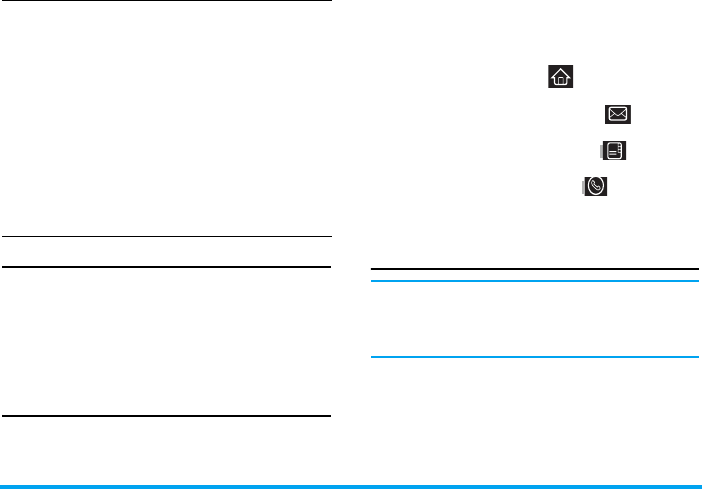
Softkeys
The left and right soft keys (
L
和
R
) located on
top of the keypad allow you to select the
corresponding options that appear on the screen
immediately above them, including during calls.
These keys are contextual: they vary according to the
current context.
Hard icons
There are 4 permanent hard icons at the top of
the touch screen, namely (from left to right):
Main menu, Messages, Contacts, Dial screen.
The 4 hard icons are available in idle mode.
When not in idle mode, only the Main menu and
Dial screen hard icons are available. During a
call, only the Dial screen hard icon is available.
Tap on the first hard icon to enter the Main
menu.
Tap on the second hard icon to enter
Messages menu.
Tap on the third hard icon to enter
Contacts menu.
Tap on the fourth hard icon to open the
Dial screen, whereby you can tap to enter
numbers.
Touch screen
Warning! The stylus pen supplied with your
product is the only tool that you can use when
tapping the touch screen. Do NOT use any other
tool on the touch screen.
Your mobile phone features a touch screen which
provides a faster and more intuitive way for you to
navigate through lists and menus. The touch screen
is operated with a stylus pen located at the side of
the phone. It becomes available as soon as you enter
any of the available menus. Use the stylus pen to tap
once or twice on any available screen zone to carry
Side
camera key
• In idle mode, short press
to enter the camera, long
press to enter video
camera.
• When in camera/video
camera preview mode,
short press to take a
photo. When in video
camera mode, short press
to start/end recording.
• When the camera/video
camera is activated, long
press to exit.
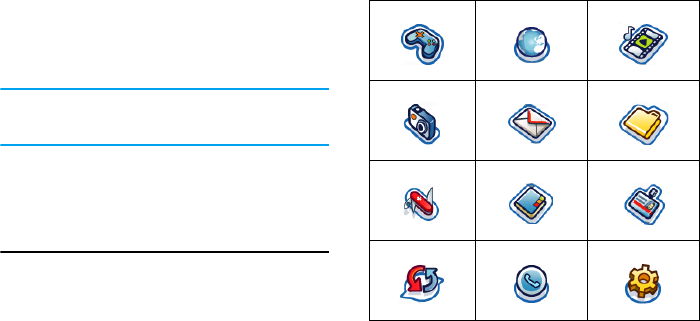
out the corresponding operations (such as menu
page header, menu items, lists, left and right
softkeys, options menu, function keys, text input
area, selection area, pull-down menu box, selection
box, etc).
You will not be able to use the touch screen in
some cases, as they are not able to replace the keys
to carry out certain operations.
The screen will display lists and menus that can be
selected with the stylus pen. You can select an item,
move up and down or select a few items
simultaneously.
Main Menu
The main menu gives you access to all the different
features of your Xenium 9@9m presented in the
form of a grid. The table below indicates the
arrangement of the Main Menu, the meanings of the
various icons found there, and the page in this
manual where more detailed information
concerning the subject can be found.
Entertainment Browser Music
page 17 page 20 page 24
Camera Messages My Files
page 27 page 32 page 46
Business Contacts Profiles
page 48 page 53 page 57
Connectivity Calls Settings
page 58 page 62 page 64

1
Table of contents
1. Getting Started ........................................... 3
Insert the SIM card .......................................... 3
Switching on the phone .................................. 5
Charging the battery ....................................... 5
Setting hotkeys ................................................. 6
2. Calling ............................................................... 7
Answer and end a call ..................................... 7
Call handsfree ................................................... 7
Options during a call ....................................... 8
Adjust the earpiece volume ........................... 8
Quickcall ............................................................ 9
MMS Foto talk .................................................. 9
Handling multiple calls .................................... 9
3. Text Entry ................................................... 12
T9 text input ................................................... 12
Basic text input ............................................... 13
Handwriting recognition .............................. 14
4. Entertainment ........................................... 16
Western Horoscope ..................................... 16
Lunar Calendar ............................................... 16
Chinese Festival .............................................. 16
Stopwatch ........................................................ 17
Countdown....................................................... 17
Games ............................................................... 17
Brick Games .................................................... 17
5. Browser ........................................................ 18
WAP ................................................................. 18
Start browser .................................................. 18
Bookmarks ...................................................... 19
Settings ............................................................. 20
WAP push setting .......................................... 21
6. Music ............................................................... 22
Tracks ............................................................... 22
Last played ....................................................... 22
Playlists ............................................................. 22
Memory status ................................................ 22
7. Camera .......................................................... 24
Camera mode ................................................. 24
Video mode ..................................................... 26
8. Messages ....................................................... 29
Broadcast SMS ................................................ 29
Email .................................................................. 29
SMS .................................................................... 34
MMS .................................................................. 38
9. My Files ......................................................... 42
Managing files .................................................. 42

2
Phone memory ............................................... 42
Memory card ................................................... 42
10. Business ...................................................... 44
Calculator ........................................................ 44
Money Converter .......................................... 44
Organizer ......................................................... 44
World Clock ................................................... 45
Sound recording ............................................. 46
Alarm clock ..................................................... 47
Snooze mode .................................................. 47
Firewall ............................................................. 47
Auto swtich off ............................................... 48
11. Contacts .................................................... 49
Settings ............................................................. 49
Name list .......................................................... 49
Edit and manage contacts ............................. 50
12. Profiles ........................................................ 53
Profile selection .............................................. 53
Personalise settings ....................................... 53
13. Connectivity ............................................ 54
Infrared ............................................................. 54
Bluetooth ......................................................... 54
USB features ................................................... 55
Network .......................................................... 56
Memory card ................................................... 57
Connections .................................................... 57
14. Calls .............................................................. 58
Call history ...................................................... 58
Clear history ................................................... 58
Call settings ..................................................... 58
15. Settings ....................................................... 59
General ............................................................ 59
Display .............................................................. 61
Sounds .............................................................. 61
Icons & Symbols ............................................ 62
Precautions ....................................................... 63
Troubleshooting ........................................... 68
Philips Authentic Accessories .............. 70
Trademark declaration ............................. 71
Limited warranty .......................................... 72
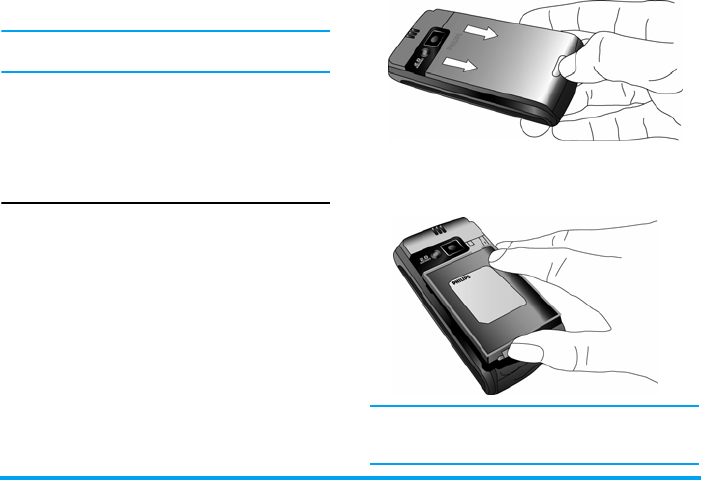
Getting Started 3
1. Getting Started
Please read the safety instructions in the
"Precautions" section before use.
To use your phone, you must insert a valid SIM card
supplied by a GSM operator or retailer. The SIM
card contains your subscription information, your
mobile telephone number, and a memory in which
you can store phone numbers and messages.
Inserting the SIM card
Follow the steps below to insert your new SIM
card. Remember to switch off your mobile
phone before removing the back cover.
Remove the back cover
To insert the SIM card, you must first remove the
back cover. Press on the back cover and then slide
the cover downwards as shown below.
Remove the battery
To remove the battery, pull the battery up from the
bottom left corner.。
You may lose all your personal settings if you
remove the battery when the phone is switched
on.
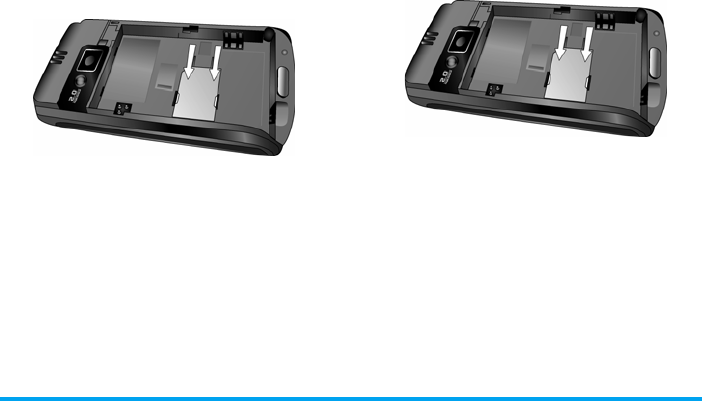
4Getting Started
Insert the SIM card
Insert your SIM card under the metal clip holder,
until it stops. Make sure that the clipped corner of
the card is in the correct corner and that the gold
contacts are facing down.
Replace the battery
Slide the battery into its slot, metallic connectors
facing downwards, until it stops. Then lock it by
pushing it downwards.
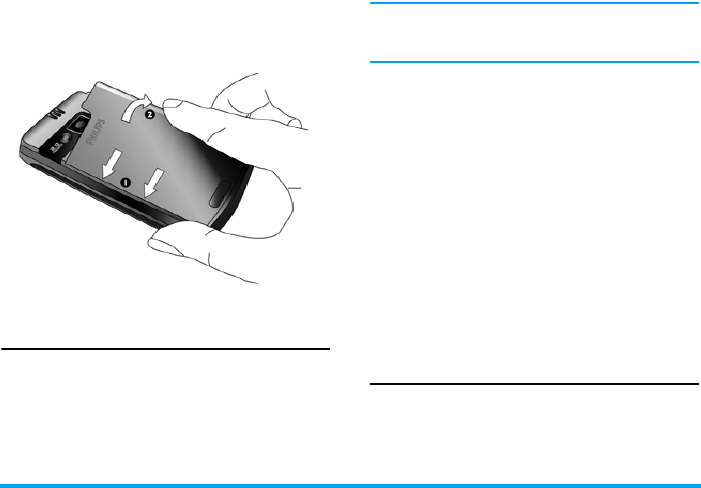
Getting Started 5
Replace the back cover
Align and hook the back cover to the left side of the
phone and press down the back cover until it locks
into place with the right side of the phone.
Remove the protective film covering the screen and
the camera lens before using the phone.
Switching on the phone
To switch on the phone, long-press the ) key.
Enter the PIN code if required. A PIN code is a 4- to
8-digit secret code for your SIM card. It is
preconfigured and communicated to you by your
operator or retailer. For more information on PIN
codes.
If you enter an incorrect PIN code three times,
your SIM card will be blocked. To unblock it, you
must request the PUK code from your operator.
When you switch on your mobile phone with your
new SIM for the first time, you will be asked for the
following:
Charging the battery
Your phone is powered by a rechargeable battery. A
new battery is partially charged and a sound alert
will warn you when the battery reaches low, if the
battery alert is On.
Set date To set the current date.
Set time To set the current time.
Time zone To select your time zone.
Copy SIM
names into
the phone?
If your phone detects any names
and telephone numbers in the SIM
card phonebook, you will be
asked if you want to copy them
into the onboard phone book. If
you wish to copy the numbers,
press OK, otherwise press Cancel.
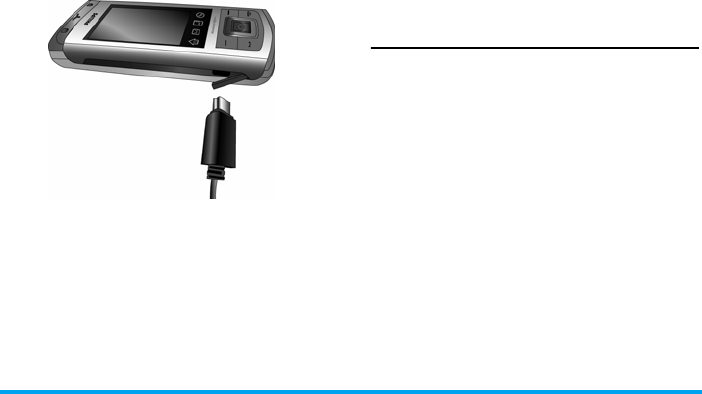
6Getting Started
Once the battery and battery cover are back in place
you can charge the phone. Pull away the protective
rubber cap covering the charger connector. Plug in
the connector as shown below. Then plug the other
end into a main AC power socket.
The battery symbol indicates the state of charge.
During charging, the charge indicators will scroll; it
takes around 2.5 hours to fully recharge your mobile
phone. When all the scroll bars are steady the
battery is fully charged. You can then disconnect
the charger.
Depending on the network and condition of use, talk
time goes up to 8.5 hours and stand-by time up to 1
month.
Keeping the charger plugged to the mobile when the
battery is fully charged will not damage the battery.
The only way to turn off the charger is to unplug it,
so use an easily accessible AC power socket. You
can connect the charger to an IT supply (Belgium
only).
Setting Hotkeys
You can configure the numeric keys 2 to 9 to
access your favourite features simply by long-
pressing on the numeric key. A number of hotkey
shortcuts are pre-configured.
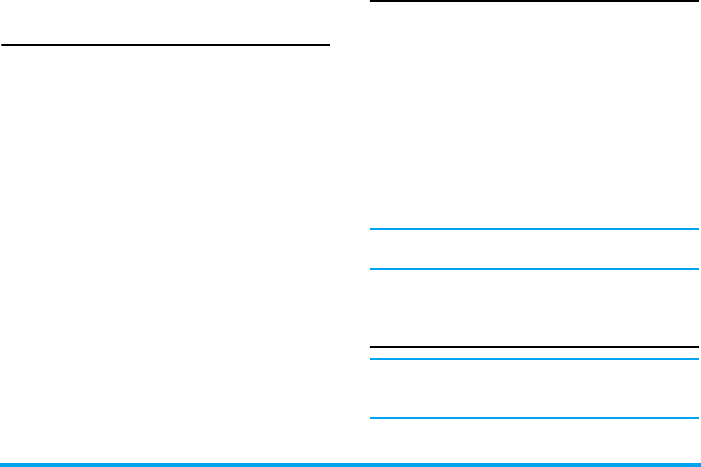
Calling 7
2 • Calling
Make a call
From the idle screen
1.
In idle mode, enter the phone number using the
keypad. To correct an error, press R C.
2.
Press ( to dial.
3.
Press ) or R End call to hang up.
For an international call, long press * to enter the
"+" sign for the international prefix.
Using the phonebook
1.
Press - in idle mode.
2.
Select a contact in the list and press (: the
selected number is dialled. If you are using the
onboard phonebook and the selected contact
features more than one number, the number
identified as the default will automatically be
selected. To select a different number, press <
or > (see °×Contacts°± µ⁄69“Š for more
information).
3.
Press ) or R End call to hang up.
Answer and end a call
When receiving a call, the number of the caller may
be displayed, depending on whether or not the
person calling has chosen to display his or her ID. If
the number is stored in the selected phonebook, then
the corresponding name is displayed instead of the
number.
•Answer the call: press ( or choose from the
menu option.
•Reject the call: press ). If you have activated
Call forward, the call is diverted to a number or
voice mail.
•Hang up: press ) or close the phone.
The phone will not ring if in Silent mode (see
µ
⁄
54“Š).
If you have selected Any Key Answer, you can accept
a call by pressing any key except ).
Call handsfree
For your own comfort and safety, ensure you move
the phone away from your ear when calling
handsfree, especially when increasing the volume.
1.
In idle mode, enter the phone number using the
keypad or select a contact in the phonebook.
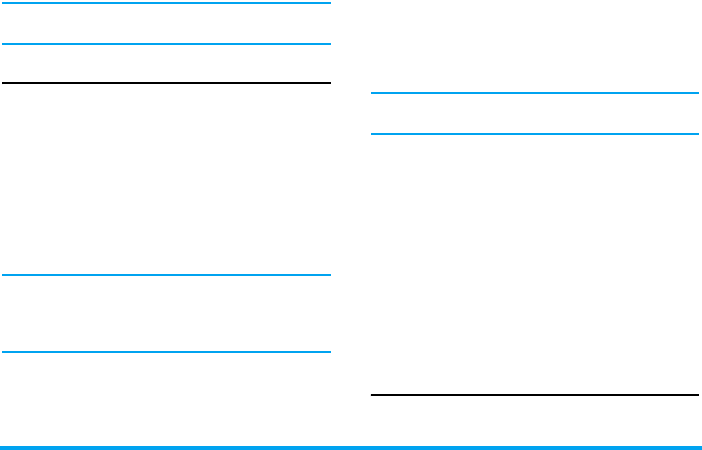
8Calling
2.
Press , or L Options then select Call handsfree
or press,.
If you are already on the phone, long press
(
to
switch to handsfree mode and back.
Options during a call
During a call, press , or L Options to access the
following options.
Activate h/free
This option allows you to use your mobile phone’s
hands-free option.
Mute / Unmute
Allows you to mute or unmute the microphone so
that your caller cannot hear you.
Record dialogue
In most countries, recording telephone
conversations is subject to legislation. We advise
you to notify the caller if you intend to record your
conversation and only do so if they agree.
To record a conversation during a call, select Record
dialogue and press ,. Press, again or L Save to
end the recording: an edit window allows you to
assign a name to the recording, which is then
available in Multimedia > Sound album.
Depending on memory capacity , recordings can be
of up to 30 minutes in total.
If you select Mute and then Record dialogue, only
the caller’s voice is recorded.
Notepad
Allows you to note down a number. You can then
store it in the phonebook, call it, or send a message
to this number.
Other options during a call
Press L Options to be able to perform the following
tasks while a call is ongoing: you can access and
consult the Name List or Call list, hang up by
selecting End call, change the Equalizer settings, send
or read SMS, or consult and manage events of the
Organizer.
Adjust the earpiece volume
During a call, press + or - to increase or decrease
the volume.

Calling 9
Quickcall
The Quickcall feature allows you to set your four
most frequently dialled numbers. You can then
quickly call one of them by selecting the
corresponding icon or picture on the screen.
Setting a Quickcall contact
1.
In idle mode, press + to access the Quickcall
screen. Select a thumbnail to configure and
press , or L Set.
2.
Select a name in the contacts list, and press ,
again to access the Picture album and select a
picture. Proceed the same way for each
thumbnail.
Calling a Quickcall contact
To make a call, press + when in idle mode, then
select the thumbnail of your choice and press (.
To reconfigure a thumbnail, select it and press , to
Replace the name and/or picture.
If a picture is already associated with a contact, it is
displayed in the Quickcall screen. Changing the
picture in one of the menus will also update it in the
other.
MMS Foto talk
This feature allows you to send a picture via MMS
and to add a sound recording to it. The picture can
be selected from the Picture album or can be a picture
you have just taken with the camera.
1.
Take a picture, then press Menu, or select a
picture from the Picture Album, then press ,or
LOptions. In both cases, select Send by... > MMS.
2.
When the Add sound? message appears, press
L Yes to start recording. Then press L Save
to stop and save your recording, or R Cancel.
3.
Rename the picture if you wish or press L OK.
4.
Select a contact in the list that appears and then
Add media to go to the MMS creation screen.
Press L Send to send your message, or
modify it as you want before sending it.
Handling multiple calls
The ability to handle two or more calls at one time
and to make conference calls is dependent on your
operator and/or subscription.

10 Calling
Making a second call
You can make a second call during an active call or
with a call on hold. While on the phone, dial a
number (or select a contact in the phonebook) and
press (. The first call is put on hold (the number is
displayed on the bottom of the screen) and the
second number is dialled. You can then press OK to
access the options among which are:
•Switch calls to toggle between calls (you can also
press < or > to switch calls).
•Transfer to connect the two calls. You are
disconnected when the transfer is completed.
•Conference to introduce the caller into a
conference call.
Answering a second call
When you receive a second call while being already
in communication, the phone emits a beep alert and
the screen displays Call waiting. You can then:
To receive a second call, you must have
deactivated the Call forward for voice calls (see
µ
⁄
74“Š) and activated the Call waiting (see µ
⁄
74“Š).
Answering a third call
If you are in a call and have one call on hold, you
can also receive a third call. To do so, you must
either end one of the calls or introduce the new
caller to a conference.
This service is limited to two current
communications (one active and one on hold).
Press(To answer the call (the first one is
put on hold).
Press)To reject the call.
Press,or
LOptions
To open the options list. You can
select End call to end the current
call, then answer the incoming
call.
Press )To reject the call.
Press,or
LOptions
To open the options list. You can
select Accept to answer the
incoming call, or End call to end
the current call, then answer the
incoming call.

Calling 11
Conference call
Subscription dependent.
A conference call is activated by making several
outgoing calls or from a multiple call context. It
allows you to speak with up to five people at the
same time.
1.
Make a first call with someone, then a second
one (see above).
2.
Press , or Options and select Conference.
Repeat the process until five members are
connected.
3.
Select Remove party to disconnect a member of
the conference, or select Private call to have a
private call with this member only (other
members are put on hold).
4.
Press ) to disconnect all calls at once.
If there is an incoming call during the conference
call and there are less than five members, you can
accept this new call and add this member to the
Conference call (if five members are already
connected, you can answer the call, but not add it to
the conference).

Text Entry 12
3 • Text Entry
Text can be entered in editing screens in two
different ways: by using T9® Predictive Text Input
or basic text input. The techniques for using these
two methods are discussed below.
T9® text input
T9® Predictive Text Input is an
intelligent editing mode for entering
text on a mobile phone. It allows you to
enter text more quickly by anticipating
the word you want to enter based on the
keys you have pushed. You press once on the key
corresponding to each letter needed to spell a word
and T9® suggests a word based on your keystrokes.
If several words are available, the first word in the
list is displayed and highlighted. Press + / - or L to
browse the list and press , to insert the word.
How to use it?
Letters and symbols represented by each key are as
follows:
Example: how to enter the word "home":
1.
Press 4 6 6 3. The screen displays the
first word of a list: Good.
2.
Press + or L to scroll and select Home.
3.
Press , or > to confirm selection of the word
Home.
Language
You can switch input language while writing a
message by long-pressing the # key. The
available languages will depend on where you
purchased your mobile phone.
2 to 9To key in letters.
L or
+ / -
To browse the list of candidate words.
Tegic Euro. Pat.
App. 0842463
>
1
,
Press any of the three keys to insert the
selected word followed by a space.
RShort press to backspace, long press to
clear all text.
0To shift letter case: Standard, lower or
UPPERCASE letters.
#To view the table of symbols and
punctuation.
*To shift mode from T9® to basic text
input to numeric.
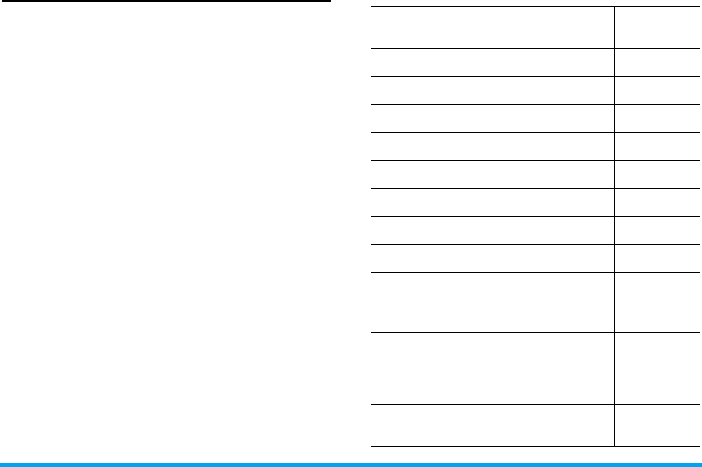
13 Text Entry
Basic text input
Press * to switch from T9® to basic text input.
This method requires multiple key presses to reach
the desired character: the letter "h" is the second
letter on the 4 key, so you must press it twice to
enter "h". Short press R Cancel to clear one entry,
long press to clear all text.
Example: how to enter the word "home":
Press 4, 4 (GHI) 6, 6, 6 (MNO), 6
(MNO), 3, 3 (DEF). Press , when the
message is completed.
Letters, numbers and symbols are located on each
key as follows:
Short press Long press
1space 1. , @ / : ; " ’ ! ¡ ? ¿ # + -
* = % < > ( ) & £ $ ¥ 1
2a b c 2 à ä å æ ç 2
3d e f 3 é è ∆ Φ3
4g h i 4 Γ ì4
5j k l 5 Λ5
6m n o 6 ñ ò ö 6
7p q r s 7 β Π Θ Σ7
8t u v 8 ü ù 8
9w x y z 9 ø Ω Ξ Ψ9
0To shift letter case: Standard,
lower or UPPERCASE
letters. 0
#To open symbols and
punctuation mode.
Changes the
language
used for text
edition
*To shift mode: T9®, basic or
numeric. N/A
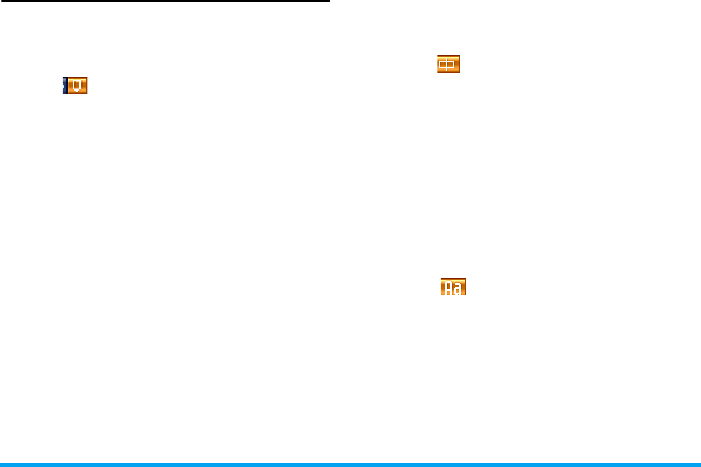
Text Entry 14
Handwriting recognition
In handwriting recognition mode, you can enter
Chinese characters, English letters, numbers,
symbols (including punctuations) by means of
handwriting recognition.
1.
Tap on the touch screen to enter the
handwriting recognition mode.
2.
Tap the corresponding icon on the touch screen
to toggle between Chinese character input
mode, English letter input mode, symbol input
mode and number input mode.
3.
Write the text with your stylus pen. The system
can recognized your handwriting automatically
and show the recognized result in the input
area, with the proposed candidate characters
displayed.
4.
If the recognized result is not the character you
desire, please choose one from the candidate
characters and tap it to replace the one in the
input area.
5.
After you have finished writing, press , to
save. You can press R to delete the character
or symbol on the left of the cursor in the text
area. Long press R will clear all contents on
the left of the cursor in the text area.
The following screen example describes the
handwriting recognition process for Chinese
characters, English letters, symbols and numbers.
Input Chinese characters
1.
Press to enter the Chinese character input
mode.
2.
Write a Chinese character with your stylus pen
on the touch screen.
3.
You will see the recognized result on the input
area.
4.
To check for more Chinese characters, press
or< or >.Choose one of the candidates
from the input line and tap it to replace the one
in the input area.
.
Input English letters
1.
Press to enter the English letter input
mode.
2.
Write an English letter with your stylus pen on
the touch screen. The system can differentiate
between the upper and lower case. You do not
need to shift case before you write.
3.
You will see the recognized result on the input
area.
4.
To check for other English letter, press or
< or >.Choose one of the candidates

15 Text Entry
from the input line and tap it to replace the one
in the input area.
Input Symbols
1.
Press to enter the symbol input mode.
2.
Write a symbol with your stylus pen on the
touch screen.
3.
You will see the recognized result on the input
area.
4.
To check for more symbols, press or<or
>.Choose one of the candidates from the
input line and tap it to replace the one in the
input area.
.
Input numbers
1.
Press to enter the number input mode.
2.
Write a number with your stylus pen on the
touch screen.
3.
You will see the recognized result on the input
area.
4.
To check for other numbers, press or<or
>.Choose one of the candidates from the
input line and tap it to replace the one in the
input area.
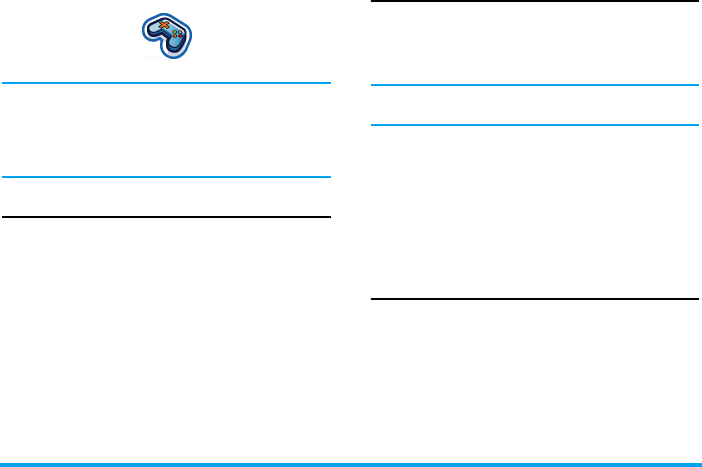
16 Entertainment
4 • Entertainment
Western Horoscope, Lunar Calendar and Chinese
Festival features are available only in the Chinese
language menu (see page 27). Your phone may or
may not have the Chinese Language menu
depending on where the phone was purchased.
Western Horoscope
This menu allows you to display your horoscope for
any given day. To consult your horoscope, you must
first either enter your sign or your birth date. If you
know your sign, you can select it from the Select sign
menu, otherwise select Set birth date, press
,
and
enter your birth date. Press , to display the
corresponding sign.
In the Horoscope menu, you can select Today or
Other day depending on the horoscope you want to
consult (in the second case, enter the relevant date
before pressing ,).
农历
Lunar Calendar
This menu gives you the correspondence between
Gregorian and Chinese calendars by displaying the
corresponding date in lunar mode from a selected
Gregorian date.
Features requiring date & time information (e.g.
organiser events) depend on Gregorian dates only.
Press , to access the date edition window. Change
the date if needed by pressing the corresponding
keys, then press , to convert to lunar mode.
Lunar in idle
This option allows you to display the lunar calendar
on the idle screen. Press + or - to activate or
deactivate this option.
Chinese Festival
This menu informs you of the next major Chinese
festivals, from a given date. Select A day from now
or select Fr. give date and enter the date from which
you want to know what Chinese festivals will occur.
In both cases, press , to display the six next
festivals.

Entertainment 17
Stopwatch
When you enter Stopwatch menu, the screen will
display Stopwatch with a start time as 00:00:0.
Press L Start or , to start the Stopwatch timer.
The soft keys will become Start/Stop and Reset.
Press
R
Reset to reset the Stopwatch. Then
R
Back
to exit.
Countdown
When you enter Stopwatch menu, the screen will
display Stopwatch with a start time as 00:00:0.
Enter the Countdown menu and enter the
countdown time in HH:MM:SS format.
1.
Press L Start to start the countdown.
2.
Press L Stop to stop the countdown timer and
press
R
Back to exit.
3.
At the end of the countdown, the phone will
emit an alarm. When you exit the countdown,
this function will be deactivated.
Games
Default games
This menu features games that are pre-installed in
your mobile phone. To start playing the game:
Java Games
Your mobile phone features Java, which allows you
to run Java-compatible applications such as games
downloaded on the network. This menu allows you
to create folders to organize the games you have
downloaded from the network via WAP.
Brick game
The goal of this game is to destroy bricks by hitting
them with a ball. Destroying all bricks give you
access to the next level.
Keys used are the following:
Press To
L
Select Main menu > Entertainment >
Games > Default games
L
Select Open the game list
L
Select Select a game
L
Options Select New game from the option
menu
L
Select Start playing the game
4 and 6 To move the racket left or right.

18 Entertainment
* and # To start the game by throwing the
ball left or right.
0To pause the game up to 2 min.
(after which the screen returns to
idle mode and the game is lost).
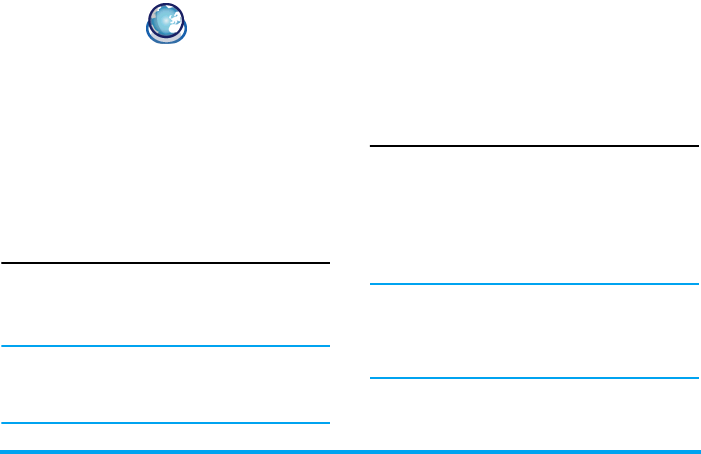
Browser 18
5 • Browser
Items in Browser menu depend on the type of
service you have subscribed to and/or the service
provider you use. Consequently, some of the menus
described below may not be available. If your phone
was pre-configured, you will not need to change the
settings described in this section.
The services provided may involve making a phone
call or sending an SMS for which you may be
charged. Contact your network operator for details.
WAP
Your mobile phone is WAP enabled. With WAP
(Wireless Application Protocol), you can connect to
the WAP network and browse special websites to
download photos, wallpapers, and ringtones, etc.
Access to WAP is dependent on your service
provider and your subscription. Please contact
your service provider for the information required
to fill in the fields described here.
Configuring WAP
Before you can connect to the WAP network, you
must first complete the following two steps:
Start browser
Your homepage is the WAP site your mobile phone
connects to by default. Your phone may be
preconfigured to connect to the WAP site of your
service provider. See Profiles to know how to set
your homepage.
To connect to your homepage, simply select
Homepage.
It is also possible to set your homepage directly in
your WAP browser. If you do so, the home page in
the browser takes precedence and it is this page
you will see when you select Start Browser in the
Browser menu.
When you are connected to the WAP site, press
either
L
or
R
to access features available on
the webpage.
1.
Configure your mobile phone's network
connection. For information on configuring
network access.
2.
Configure your WAP push message settings.
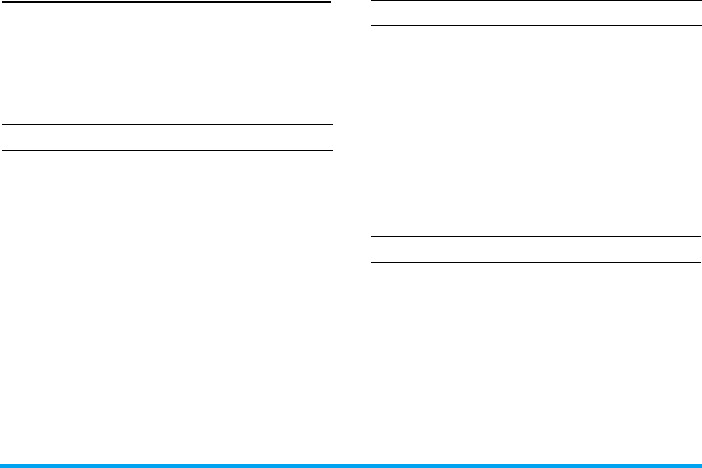
19 Browser
Bookmarks
This menu allows you to manage a list of your
favorite WAP sites, much as you might do with a
"Favorite" or "Bookmarks" menu in an Internet
browser. In this way, you do not have to enter the
address for a site whenever you want to visit it.
To add a new bookmark/folder:
Bookmarks folder options
Bookmark options
Press To
L
Select Main menu > Browser > Bookmarks
L
Options Go to the option menu.
+
or
-
Select to add New Folder or New
Bookmark.
L
Select Go to edit screen and enter
information such as Title and
Address for New Bookmark or Title
for New Folder.
Press To
L
Select Main menu > Browser > Bookmarks
+
or
-
Navigate to the desired folder
L
Options Options under bookmarks folder
include:
•Edit
•New folder
• New bookmark
• Delete
• Delete all
Press To
L
Select Main menu > Browser > Bookmarks
+
or
-
Navigate to the desired Bookmark

Browser 20
Settings
This feature allows you to customize the settings of
the way you connect to your WAP service. You can
create a number of profiles with different settings.
Edit WAP parameter
L
Options Options under each Bookmark
include:
•Edit
•Move
• New Folder
•New Bookmark
•Delete
• Delete all
Press To
L
Select Main menu > Browser > Settings >
WAP profiles
R
Options Go to WAP parameter and edit
details.
Options Description
Name To name the current profile
IP address To enter the IP address of your
WAP service
Port To enter the IP port number of
your WAP service. This is usually
port number 9201.
Homepage To enter a WAP site address to
which you will connect directly
when connecting using the related
profile.
Linger time When you have reached the
inactivity timeout (in seconds),
your phone will automatically
close the WAP connection.
Connection To toggle between different way
to connect to the WAP service:
Auto, CSD or GPRS. If the GPRS
network is not available upon
connection, a message will ask
you if a CSD connection should be
made instead.
CSD
profiles
Toggle between different CSD
profiles that you have defined in
Connectivity.

21 Browser
WAP push setting
WAP Push is a service for the asynchronous
delivery of content to the mobile device. Use this
menu to turn on or off the reception of message
broadcast on your network and/or from your service
provider. Or you may specify to allow SMS centers
from specific area to send you the messages. From
main menu > Brower > Settings > Push messages.
Push messages Options
Push messages include URL links for quick access
to the corresponding WAP services: a single click
on the WAP Push message will connect to the WAP
site for browsing or downloading multimedia files
into your handset.
GPRS
profiles
To toggle between different GPRS
profiles that you have defined in
Connectivity.
Options Description
Always
accept
Turn on the message broadcast
service for all the messages.
Never
accept
Turn off the message broadcast
service for all the messages.
Only from
address
Specify a certain area by adding its
area code.
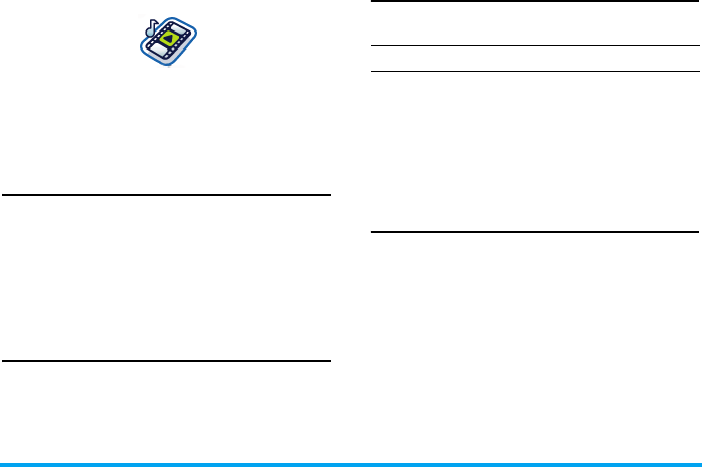
22 Music
6 • Music
This feature allows you to download music from the
network, save the sound files, edit your play list, and
play the music. The phone can support MP3 and
AAC format.
Tracks
This feature allows you to play downloaded music
from either the Phone memory or Memory card. For
example, to play tracks from an inserted mini-SD
card, select the Tracks option and then on the next
screen select Memory card. From the listed tracks,
select the music file you want to play and then
press,.
Last played
This feature provides a list of songs that you
previously played. The list of songs is arranged
chronologically.
Playlists
This feature allows you to edit your favorite song
list. To edit your playlist:
Memory status
This menu allows you to display the percentage of
memory available in your phone. Various features
share the memory capacity: pictures, sounds,
recorded memos and voice tags for voice
commands, stored messages, phonebook and
organiser entries, games, etc.
Press, to check the memory status. The display
shows you the percentage of memory free and the
phone’s total memory in Kilobytes (Kb). Press ,
again to check the detailed list of memory used by each
feature.
Press To
L
Select Main menu > Music > Playlists >
<New playlist>
+
/
-
L
Select
Scroll to the desired playlist. Open
the option menu to Open, Play,
Delete, Rename the playlist or get
more information in Help.

Music 23
Your mobile phone is supplied with many sounds
and pictures. You can only delete sounds or pictures
in the My melodies or My images folders, e.g. to free
memory space for your own sounds and pictures.
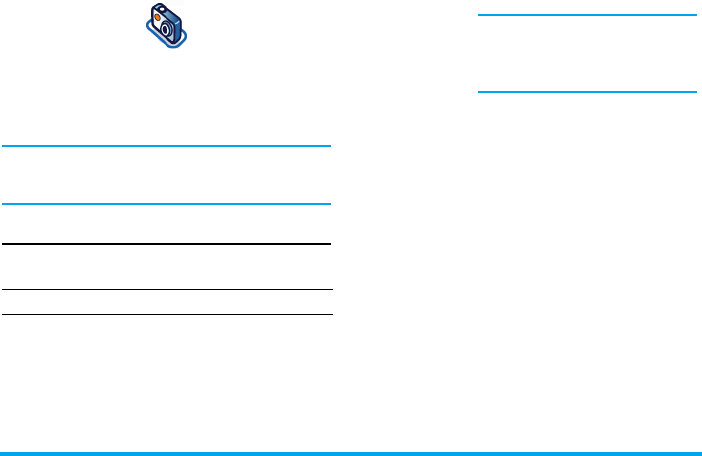
24 Camera
7 • Camera
Your mobile phone features a digital camera that
allows you to take pictures (up to 1.3 Mega pixels)
and record short videos, store them in your phone,
use them as wallpaper or send them to your friends.
Ensure the camera lens is clean before you take
pictures as small dust can strongly affect the
result.
Camera mode
Consult the table below on how to perform common
operations with your camera.
Within any menu, press power key to cancel any
current action and go back to idle mode. Once they
have been saved, pictures / videos are available in
My Files > Pictures / Videos.
Press To
,or
Camera side
key
From main menu > Camera
or
Launch camera mode directly.
Side keys +
and - Zoom in/out (when the camera is
active)
Zoom behaviour depends on
camera resolution setting. The
lower the resolution, the higher
the zoom factor.
<
/
>
Switch between camera or video
mode.
+
/
-
Adjust brightness (when the cam-
era is active)
,or
Camera side
key
Take a picture, which will be
saved right after the shot
*
Press
*
to activate/deactivate
the flash.
L
Options
or,Open the option menu

Camera 25
Camera option menu
When the camera mode is activated and before a
picture is taken, you can change a number of
settings by pressing
L
Options.
Once you have activated the camera, simply press
,to take a picture. The picture is automatically
saved. Once the picture is saved, you can then press
L
Options to access the following list:
Options Description
Preview
screen
Select to view with a Large/Small
screen.
Picture
resolution
Adjust from five image sizes:
160X120, 320X240, 640X480,
800X600 and 1280X1024.
Picture
Quality
Select among three image quality:
Super fine, Fine and Normal.
View
pictures
Select to view the pictures taken.
Flash light To activate or deactivate the flash
mode.
Mode Three modes for selection: Night
mode, Self-timer and Multi-shot.
Multi-shot is only available when the
picture resolution is 800X600 or
lower.
Colour
effects
Select to add special colour effects
to the picture.
Advanced Edit more detailed information:
•Default name: Enter default name
for the picture.
•Reset settings: Restore default
values.
•Anti-Flicker: Select between 50Hz
or 60Hz.
Options Description
Send To send the picture Via multimedia msg,
Via Bluetooth, Via infrared or Via e-mail.
Take new
picture
Return to the viewfinder screen.
As contact
ID
To set as the display image when
there is an incoming call.
As
wallpaper
To set the picture as a wallpaper to
be either Full Screen or Fit Screen.
Delete Delete the picture.
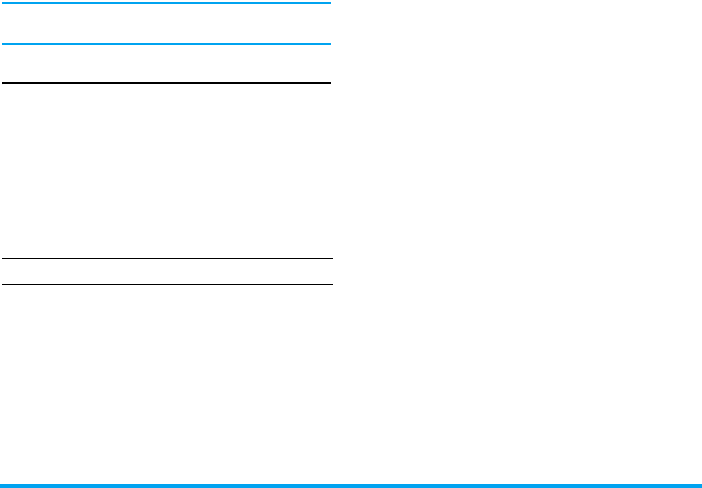
26 Camera
When the photo album is full, a warning message
will pop-up.
Video mode
This option allows you to record short videos,
which you can play, save in the phone, or in an
inserted memory (mini-SD) card, or send to
someone via MMS or e-mail.
Note that the phone's internal memory can store
approximately 350KB of video. When recording to
an mini-SD card, the amount of video you may store
is dependent upon the size of the mini-SD card.
How to record Video?
Video option menu
When the video mode is activated and before you
start recording, you can change a number of settings
by pressing
L
option.
Press To
L
Select
or Camera
side key
From main menu > Camera or
Launch Camera directly.
<
or
>
To scroll the phone from camera
mode to video mode. Note that the
icon on the upper left screen
indicates which mode you selected.
,Start recording a video.
+
/
-
Adjust brightness (when in
recording mode)
+ / -
Camera
side keys
Zoom in/out (when in recording
mode)
L
Stop Stop recording and save the video
right after the shot
L
Options
Open the option menu
Options Description
Preview
screen
Select to view with a Large/Small
screen.

Camera 27
Once you have activated the video mode, simply
press,to start recording. Press
L
Stop to stop
recording and save the video. Once you have saved
the file, you can then press
L
Options to access
the following list:
Video
length
Select from MMS length , Maximum
length or Unlimited.
To set the video length as
Unlimited, please make sure that
you have selected the Memory Card
option from Settings > General >
Default Storage.
Video
resolution
Select video size: 352x288 or
176x144
Video
quality
Select image quality: Fine and
Normal.
View videos Select to view the recorded video.
Flash light Select to turn on/off the flashlight.
Colour
effects
Select a colour effect.
Advanced Edit more detailed information:
•Default name: Enter default name
for the video.
•Reset settings: Restore factory
settings.

28 Camera
Video menu options
When video album is full, a warning message will
pop-up.
Options Description
Play Play the video that you just
recorded.
Send Send the video file.
Record new
video
Return to video mode to record new
videos.
Delete Delete the video clip.
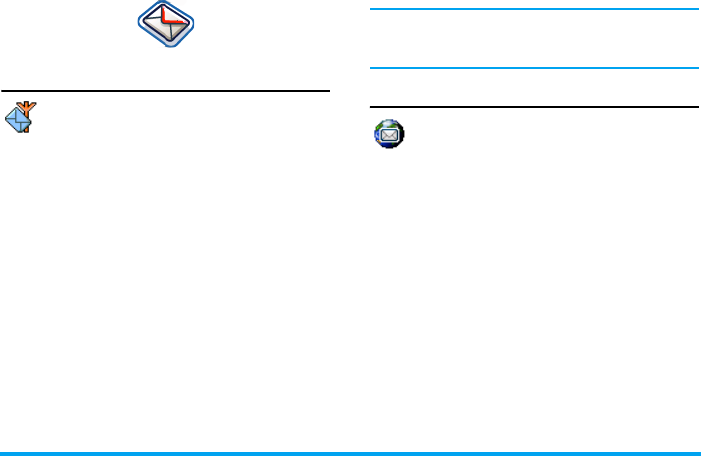
Messages 29
8 • Messages
Broadcast SMS
This menu allows you to manage the
reception of SMS broadcasts regularly
transmitted to all subscribers on the
network. It gives you access to the
following options:
District code
To select the type of messages you want to be
permanently displayed on the idle screen (in this
case, enter the type in both District code and Topics
menus).
Reception
To set the reception of cell broadcast messages On or
Off.
Topics
To define the type of messages you want to receive.
To configure a topic, select <New>, enter the code
provided by the operator, and, if desired, associate a
name. You can also select an existing topic in the
list, which you can rename or delete.
You can enter up to 15 different topics in the list.
To obtain the codes corresponding to the different
topics, contact your operator.
E-Mail
This menu allows you to access your e-mail
with your Xenium 9@9m mobile phone.
You can send and receive e-mails with
attachments from two different e-mail accounts.
Depending on your service provider and your
subscription, your mobile
phone may have been
pre-configured with an e-mail account, in which
case the parameters are already set.
If not included in your mobile phone contract, you
will need to subscribe to an e-mail service in order
to send and receive e-mails. In this case, all
parameters are communicated to you by your
provider.
The sections below describe in detail how to
configure your mobile phone for e-mail.
Settings
To configure an e-mail account, select one and press
, to access the menus detailed below.

30 Messages
Rename profile
To rename an account from its default name. If one
of the accounts has been pre-configured, it may be
locked, in which case it cannot be renamed.
Email server
To configure the settings needed to connect to your
e-mail service.
You must obtain the POP3 and SMTP addresses
from your e-mail service provider.
If you wish to use a GPRS connection to access
your e-mail, you may need to use the SMTP server
of your mobile service provider to send e-mails.
Advanced
Network access
Before you can consult your e-mails, you first need
to configure your connection to the internet.
GSM Settings
When you use a GSM connection to connect to the
internet, your mobile phone dials a number
provided by your network operator and the data is
sent and received over this connection, somewhat
like a dial-up internet connection from a PC. The
GSM connection parameters are described in the
table below.
Password The password to access your e-mail
account.
E-mail
address
Your e-mail address.
SMTP
address
The Simple Mail Transport Protocol
(SMTP) address. This is the server for
your outgoing mail and is usually in a
format like smtp.yourmail.com.
POP3
address
The Post Office Protocol (POP)
address. This is the server for your
incoming mail and is usually in a
format like pop.yourmail.com.
Login The login (or user name) to access
your e-mail account.
POP3 port The port number on the POP3
server. This is usually port 110.
SMTP port The port number on the SMTP
server. This is usually port 25.
DNS
address
The IP address of your Domain
Name Server.
SMTP
authent.
SMTP authentication is usually set
to Off. Contact your provider for
more information.

Messages 31
GPRS settings
If using GSM is like a dial-up internet connection, a
GPRS connection would be the equivalent of
broadband. GPRS (or Global Packet Radio Service)
is a protocol for sending data rapidly using a radio
signal.
To configure a GPRS connection, you may need to
provide a a user name and password, although some
GPRS connections function without them. You will
need to provide the APN (or Access Point Name).
Bearer
This menu option allows you to choose which how
to establish an internet connection.
•GSM: your mobile will only use the GSM
network for e-mail connections.
•GPRS: your mobile will only use the GPRS
network for e-mail connections.
•GPRS first: your mobile will first try to connect to
the GPRS network. If no GPRS network is
available, then it will try with the GSM network.
For these features to work, you must first have
entered the corresponding settings.
E-mail inbox
This menu allows you to connect to your mailbox
and download the e-mail headers (sender and
subject lines) from the server. You may then choose
to retrieve the corresponding e-mails.
1.
Select E-mail inbox: your phone automatically
connects to the e-mail server and downloads
the list of e-mail headers if any (five at a time).
2.
If Next (or Previous) appears at the end (or
beginning) of the list, other e-mail headers are
pending: select one of the available options
and press , to retrieve them.
Phone
number
This is the number your mobile
phone dials to establish a connection.
First choose ISDN No. or Analogue No.
(depending on your network
operator) and then enter the Phone No.
provided by your operator.
Login &
Password
The login and password provided by
your GSM network operator to
access this service.
Auto
disconnect
Enter an inactivity time-out value
after which the phone will
automatically end the call (if a
connection was in progress). The
value must be over 30 seconds.
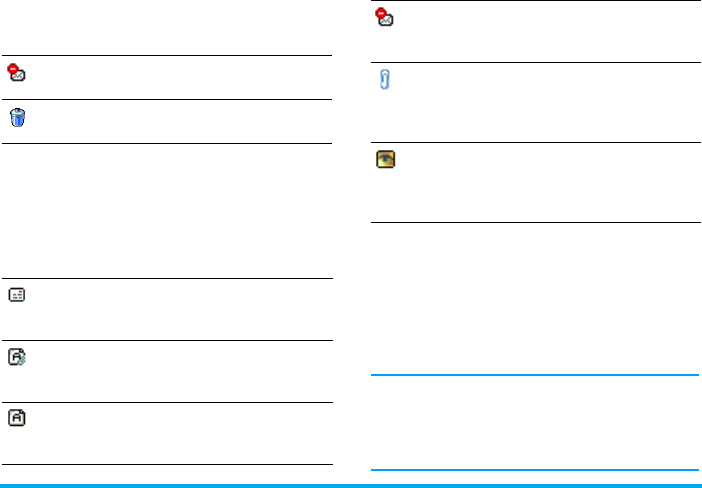
32 Messages
3.
Select a header, and press , to display the
Details. The following status icons may appear
to each header:
4.
If there is no icon next to the header, you can
press , and select Get mail to download the
e-mail. Repeat this operation to download each
e-mail corresponding to each selected header.
If the e-mail you have received contains
attachments (an image, a text file, or another
e-mail), they are identified by a specific icon:
You must download and save a picture before you
can view it in the Picture album. If there isn’t enough
memory to store the new picture, you must delete
other items (images, sounds, messages, etc.) to free
up memory to save the new picture.
An image file may not be accepted by your mobile
phone if it isn’t in the correct format. Images must
be in JPEG, BMP or GIF format.
The optimal image size is 128 x 160 pixels (the
dimensions of the screen). If you are transferring
images from your home computer, you can use an
image editing program to create images of the
correct size.
The e-mail size is too large (over 50 Kb),
it cannot be downloaded.
The e-mail is marked to be deleted (see
µ⁄33“Š).
Contains the details of the e-mail header
(date and time, sender’s e-mail address,
etc.), press , to display these details.
The text of the e-mail itself can be viewed
as an attachment, press , to read it (no
advanced options in this case).
A text file (text only, ".txt" format) is
attached to the e-mail, press , to read it
(no advanced options in this case).
The application needed to manage this
attachment isn’t available in your phone,
or the e-mail is too large to be uploaded.
Another e-mail is attached to the one you
received. Up to five e-mails can be
attached, although there will be no
advanced options.
A picture is attached to this e-mail. Select
it in the list and press , twice to store it
in your phone (you can rename it if you
wish).

Messages 33
5.
Select an e-mail header and press , to access
the following options: New mail
This menu allows you to send e-mails to one or
several recipients at a time, including with an
attachment such as a JPEG picture. Once received,
your messages can be forwarded and the
attachments visualised with the appropriate
software.
If you exit the New mail menu before sending your
e-mail or if you cancel the sending while it takes
place, the e-mail content is deleted without being
stored.
Add to
contacts
To add the sender’s e-mail address to
your phonebook, even when you
haven’t yet downloaded his e-mail.
Select <New> to create a new contact,
or a name in the list to add or change the
e-mail address.
You must have selected the phone
phonebook in this case; this menu item
will NOT appear if you selected the
SIM phonebook.
Delete To mark the e-mail to be deleted (select
this option again to unmark it). When
you exit the E-mail menu, you will be
asked to confirm deletion of the selected
item(s) from the e-mail server.
Reply To reply to the sender (whose address
will be automatically added to the list).
Proceed as described in °×E-mail
inbox°± µ⁄31“Š.
Forward To forward the downloaded e-mail to
someone else. Proceed as described in
°×E-mail inbox°± µ⁄31“Š.
Add
contacts
To select the recipient(s) of your e-
mail, provided that you have entered
e-mail addresses for contacts saved in
your phone phonebook.
After you have added contacts, select
one of them and press ,to Change
the e-mail address, Remove it from the
list.
If you select a contact from the SIM
phonebook, an edit window will allow
you to enter an e-mail address.

34 Messages
You can only attach one picture (JPEG, GIF or
BMP) or one sound at a time. If you accept an
incoming call while writing an e-mail, the menu is
closed and the phone goes back to idle when you
hang up.
SMS
This menu allows you to send text messages
using the Short Messaging Service (SMS)
and to manage the messages you send and
receive.
New SMS
To compose and send an SMS, follow the steps
detailed below:
1.
Select New SMS, then Enter phone no. or From
contact list and press L Select or ,.
2.
Enter a number or select a contact and press ,,
then one of the following options:
3.
Enter your text and press , to access the next
options:
Add
media
Allows you to design your message.
Enter the subject and text, then press ,
to access the next options:
•Add sound or Add graphic to attach a
sound or a picture to your e-mail,
•Send now to send it to the selected
recipient(s),
•Modify to redesign your e-mail.
<New> To write a new message.
Last
message
To edit, modify and re-send the last
message sent.
This menu also lets you recall the
message you were entering and
might have lost if you pressed the
( key by accident and returned to
idle screen.
Template To select a pre-configured message
such as Can you ring me back on this
number?
Save To store the current message and its
attachments in the Archive menu.
Send now To send the current message.
Add sound To attach a melody.
Add graphic To attach an image or an animation.
Language To change the language for typing.

Messages 35
You can send up to two attachments of two different
types together with your SMS. Images and
animations and pictures are exclusive: if you first
select an animation and then an image, only the
image will be taken into account and vice-versa.
Copyright protected pictures and sounds cannot be
sent by SMS.
SMS Inbox
This menu allows you to read SMS messages you
have received. The messages are displayed in a list.
At the end of the list, the <Delete All> item allows
you to delete all the messages at once. Deleting old
messages is useful to free memory space in order to
receive new messages.
When a message is displayed, press , or L
Options to access the menu options listed below.
Extracted
No.
To extract a number included in
the message itself, if this number
is included in double quotes
(several numbers can be included
and extracted). This menu is only
visible if there is a number to
extract.
Store number To save the number of the sender
if it is attached to the message.
Delete To delete the selected message.
Reply by SMS To reply to the sender.
Forward to To forward the selected message.
Note that attachments cannot be
forwarded.
Call back To call the sender of the message
(operator- dependent).
Call
handsfree
To call the sender of the message
handsfree.
Move to
Spam Box
To move the selected message in
the Spam Box (this will delete it
from the SMS Inbox).
Add to
blacklist
To add the sender’s phone number
to the Firewall blacklist (see
µ⁄20“Š for details).
This option isn’t available if the
sender’s identity (i.e. his phone
number) is hidden.

36 Messages
Spam SMS Box
This menu lists all SMS that were rejected via the
Firewall option. Select a message in the list and
press L Options to access the following items:
Move to
archive
To store messages in the phone
memory. You can then consult
them in Messages > SMS > Archive.
Moving a message to the archive
deletes it from the SMS Inbox list.
Edit SMS To edit, modify and resend the
SMS to someone.
Store melody To save the melody that was sent
with the SMS. This menu is only
visible if there is a melody to
extract.
Store graphic To save the graphic and/or
animation that was sent together
with the SMS. This menu is only
visible if there is an image to
extract.
Add to blacklist To add the sender’s phone
number to the Firewall
blacklist.
This option isn’t available if
his identity (i.e. phone
number) is hidden.
Move to inbox To move the selected message
in the SMS Inbox (this will
delete it from the Spam Box).
Delete To delete the selected message.

Messages 37
Settings
This menu allows you to configure the SMS
settings. The options are:
SMS chat When On, allows you to display
received SMS on the idle screen.
You can then quickly reply to a
message received by pressing ,,
entering your message in the edit
screen, and pressing , again.
If you receive an SMS while you
are reading one, you can reply to the
first one before reading the second.
Alternatively, you can press Back to
exit the first message. The second
message then appears on your
screen.
Delivery
report
When On, this option will inform
you via SMS whether your own
SMS was received or not. This
feature is subscription
dependent.
Auto save
SMS
When On, this option will
automatically save messages sent in
the Archive menu.
SMS center To select your default SMS centre.
If not available on your SIM card,
you must enter your SMS centre
number
.
Signature When On, allows you to add a
signature at the end of your
message. You can Edit, Change or
Save the signature.
Validity
period
To select the length of time your
messages are to be stored in the
SMS centre. This is useful when the
recipient is not connected to the
network (and thus cannot receive
your message immediately). This
feature is subscription
dependent.
Reply path When On, this option allows you to
transmit the number of your SMS
message centre together with the
message. The recipient can then
reply using your own SMS centre
and not theirs. This speeds up the
rate of transmission. This feature is
subscription dependent.

38 Messages
Archive
This menu allows you to consult all the messages
stored in the phone’s memory using the Auto save
SMS or Move to archive options. The <Delete all
SMS> item allows you to delete all SMS at once.
When a message is displayed, press , or
LOptions to access the following options: Delete,
Edit SMS, Forward to, Call back, Call handsfree.
MMS
Your mobile phone can also send and
receive MMS (Multimedia Messaging
Service) messages. With MMS you can
send messages that contain pictures,
sounds, and text.
When sending MMS messages, your recipient must
also have an MMS-enabled phone in order to be
able to view your message.
Receiving MMS
If someone sends you an MMS, an icon and a sound
alert will inform. If the sender of the message has
asked for a Read report, a prompt will ask you to
send it or not. Once the MMS is downloaded, it is
available in MMS > Inbox (see below).
If the size of the MMS to download is bigger than
the memory available in your phone, you must free
memory by deleting data (picture, sounds, etc.).
New MMS
When you select Create MMS, you are first asked to
enter the contact to whom you wish to send the
MMS. You can select one or more existing contacts
or enter a new mobile phone number.
Next you will be asked to Add media. In the MMS
creation screen, five icons allow you to Add picture,
Add text, Add sound, Send the message or access the
MMS options. Use+or-to move from one
option to the next and press , or L to access the
menu.
1.
Design your message: Add picture, Add text
and/or Add sound. Press>to create more
slides.
2.
The last icon on the left-hand side lets you
access the MMS options (see below).
3.
Select Send to send the MMS to the selected
recipient(s).
Pictures are chosen from the Picture album.
Copyright protected pictures cannot be sent via
MMS.
Sounds can be chosen from the Sound Album
melodies. If you wish to send a sound memo, you
need to record it when creating the MMS. In this
case, in Sound... menu, select <Records>, then
<New> and follow the procedure that appears on the

Messages 39
screen. Recordings previously saved cannot be sent
via MMS.
The following options are available when creating
new MMS messages:
Once your message is completed, select Send now
and press ,. A progress bar allows you to follow
the sending of your message, press LCancel if you
wish to cancel the sending. If you saved the MMS
as a draft, it will be available in the Drafts menu. If
you have sent the MMS, it is available in the Outbox.
Inbox
You MMS inbox lists all the Read and Unread
MMS, Notifications, Delivery and Read reports. To
read a message, select it and press >. Press , or L
Options to access the following options:
Add Slide To create a new slide and add it to
your slide show. Press < or >
to browse slides once you have
created several.
Next slide /
Previous slide
To move to the next/previous
slide. Note that this option only
appears if the MMS contains more
than one slide.
Edit subject To edit and change or enter the
subject of your message.
Delete slide To delete the selected page (if
there is more than one in the
message).
Save
as draft
To save your message as a draft
that you can edit, complete and
send later on.
Save
as template
To save your message as a
template, that you can use as a
basis for other MMS (e.g. "Happy
birthday" type of message.
Preview MMS To preview the slide show you
have created.
Slide duration To change the value of slide
duration set in Settings >
Application settings and to set a
delay between each slide.
Play To switch back to automatic
mode: the MMS is then played
as a continuous slide show.

40 Messages
Do NOT delete notifications before you have
retrieved the MMS, or you will not be able to
retrieve the MMS. Notifications are automatically
deleted once you have received the full MMS.
Drafts
Lists all messages saved as drafts, or automatically
saved if you quit the MMS menu before saving or
sending your MMS. You can Play, Edit, Send, view
Details and Delete drafts.
Templates
Lists all messages saved as templates. You can Play,
Edit and Delete them.
Outbox
Lists the messages you have Sent or created but Not
sent yet. You can Play, Delete or view the Details of
all these messages, Send or Forward them to
someone.
Messages you have saved can only be sent from the
Draft or Outbox folders. You can NOT recover an
item (whether message, notification or report) that
you have deleted. Press
R
Back to cancel deletion.
Settings
Your phone may have been pre-configured to
directly access the services offered. If not, contact
your operator to receive the information items
described in the present section and enter them as
given. With some operators, access parameters
can be set «over the air».
Choose an MMS profile in the list and select Modify
to access the following settings.
Next / previous
slide
To move to the next or previous
slide. You can also press < or >
when viewing the MMS in
manual mode. Note that this
option only appears if the MMS
contains more than one slide.
Save picture To detach the picture of the
current slide and save it in the
Picture album.
Save sound To detach the sound of the
current slide and save it in the
Sound album.
Close To close the MMS and go back
to the list of options.

Messages 41
Application settings
Retrieval
mode
Allows you to choose from:
•Manual: you connect manually to the
server by selecting a notification in
the Inbox, selecting Read to
download, then Play.
•Automatic: new MMS are directly
placed in the Inbox. Select the MMS
and press > to play it.
This mode is deactivated when
roaming.
Validity
period
To select how long your MMS will be
stored on the server, from 1 hour to 1
week (maximum). This is useful when
the recipient is not connected to the
network (and thus cannot receive your
message immediately).
Read
report
This option can be set On or Off and
informs you (via an SMS) when the
status of the MMS you have sent has
changed, i.e. if it was read or deleted.
Delivery
report
This option can be set On or Off and
informs you (via an SMS) of the status
of delivery, e.g. if your MMS was
received or rejected.
Auto
save
This option can be set On or Off and
allows you to automatically save the
messages sent in the Outbox menu.
Slide
duration
Allows you to select the duration
between each slide of the MMS.
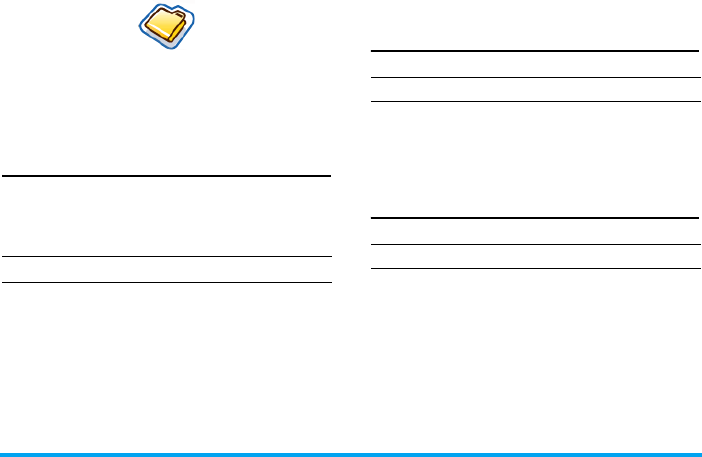
42 My Files
9 • My Files
his menu allows you to manage your files by storing
into different folders. Moreover, you may use
Memory status to get the memory capacity
information of your phone or mini-SD card.
Managing files
You may cut, copy, and paste the files in My files.
However, the phone can’t copy big files from mini-
SD card to internal memory (up to 350KB).
To cut, copy, or paste any files in My files:
Phone memory
To see all the files saved in the handset memory:
Memory card
To see all the files saved in the external memory:
Press To
L
Select From main menu, select My files >
Pictures or Sounds.
+
or
-
Scroll to the desired file.
R
Options Open the Options menu.
+
or
-
Select Organise > Cut or Copy.
+
or
-
Go to the desired folder.
R
Options Open the Options menu.
+
or
-
Select Paste here.
Press To
L
Select From main menu, select My files >
Memory status
+
or
-
Navigate through Free memory,
Used and Total size.
Press To
L
Select From main menu, select My files >
Memory card.
<
/
>
Scroll between My Files of the
phone’s memory and Memory
card.
+
or
-
Navigate through files that are
saved in memory cards.

My Files 43
Please see Settings > General > Default storage
µ
⁄
59“Š to change the default location storage.
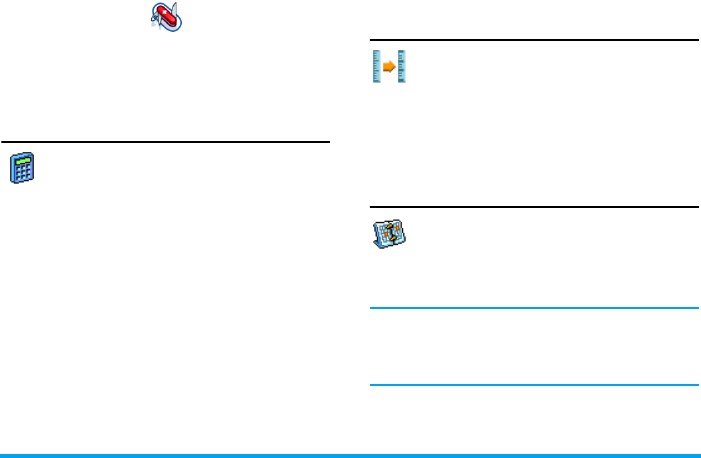
Business 44
10 • Business
This menu contains features and options designed to
help you keep you organised and informed while on
the move.
Calculator
Your phone has a built-in calculator that
you can use to perform basic calculations.
Numbers are entered with the keypad and
operators with the navigation keys as indicated in
the table below:
An icon at the top of the screen indicates which
navigation keys to use for entering operators.
Press and hold 0 to get the decimal point.
Calculator accuracy is to 2 decimal places and is
rounded up to the higher decimal figure.
Money converter
This menu allows you to convert a sum
from one currency into another using the
exchange rate of your choice. You can
convert from Local to Foreign or vice versa. Enter a
rate in the Exchange rate field and an amount in
either the Local or Foreign fields: the sum is
calculated automatically.
Organizer
This menu allows to create, store and
manage events in your organiser. When the
organiser alert is On (see “Sounds alerts” on
page 54), a beep or a sound recorded alerts you
when an event is due.
The organiser shares the mobile memory capacity
with other features (phonebook, picture album,
sound, etc.). To check the memory available in
your phone, select Multimedia > Memory status.
Creating a new event
1.
In Events, select <New>, then the type of event
to create (Holiday, Meeting, To Do).
Addition
Press > or the * key.
Subtraction
Press < or the * key twice.
Multiplication
Press + or the * key 3 times.
Division
Press - or the * key 4 times.
Equals
Press , or #.

45 Business
2.
Enter the starting and ending date and time of
the event and name it (e.g. "Meeting with
Smith").
3.
Set a reminder and a frequency: alerts will be
triggered at the chosen time.
The reminder only applies to Meeting and To Do
events. It will be updated when changing time
zones (see °×World clock°± below).
Deleting old events
This menu allows you to delete past events. Enter
the starting date (past or future) from which all
previous events will be deleted and press , twice
to delete all events preceding this date.
To delete all events set in your organiser, enter a
starting date several years ahead (e.g. 31st of
December 2010) to make sure all events preceding
this date are deleted at once.
Managing events
Select an event in the list and press , or L Options
to access the following options:
Changing a repeating event modifies all instances
of this event.
Events views
Events stored in your organiser can be displayed in
Day view, Week view and Month view. Select a view
format and press ,, then use < or > to display the
previous or next day, week or month.
World clock
This menu allows you to set and display
both the local time and the time in the
foreign time zone of your choice. Note that
if you choose to display the local and foreign time
on your home screen, the image you selected as
your wallpaper will no longer be displayed there,
Delete To delete the selected event.
Change To change the selected event.
Send by
infrared
To transmit the selected event to
another infrared-compatible device.
Change
sound
To change the sound associated with
the alarm type of the selected event.
Play sound
To play the selected melody.
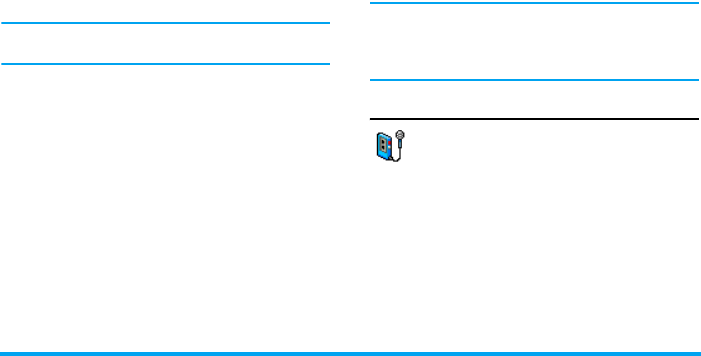
Business 46
but will be replaced with the standard International
clock wallpaper.
World clock
Activate this option if you want to display both the
local time and the time of another time zone on the
idle screen. Press + or - to set the option On or Off.
When On, the new menu item Switch local and foreign
allows you to display the zone of your choice.
This feature is not available when the option No
clock is selected in “Clock display” on page 53.
Local settings
Foreign settings
Alarms, reminders, programmed events are time
zone independent! If you set an alarm or an event
at 9:00 AM in time zone A, it will still ring or be
due at 9:00 AM if you change to time zone B.
Sound recording
This menu allows you to make recordings
of up to 12 minutes in length, depending on
the memory status.
Select <New> to begin the recording. The
message Speak now appears along with a progress
bar. When you are finished, press L Save to stop
recording. You can then either enter a name for the
new sound file or accept the default name proposed
by pressing ,. You then return to the list of Sound
recordings and the new recording is displayed in the
list.
Set time Allows you to set the time by
pressing the appropriate keys.
Local zone Move + or - to select the time
zone corresponding to your area.
Daylight saving Allows you to set the daylight
saving option On or Off for the
local time zone.
Foreign zone Move + or - to select the time
zone of your choice.
Daylight saving Allows you to set the daylight
saving option On or Off for a
foreign time zone.
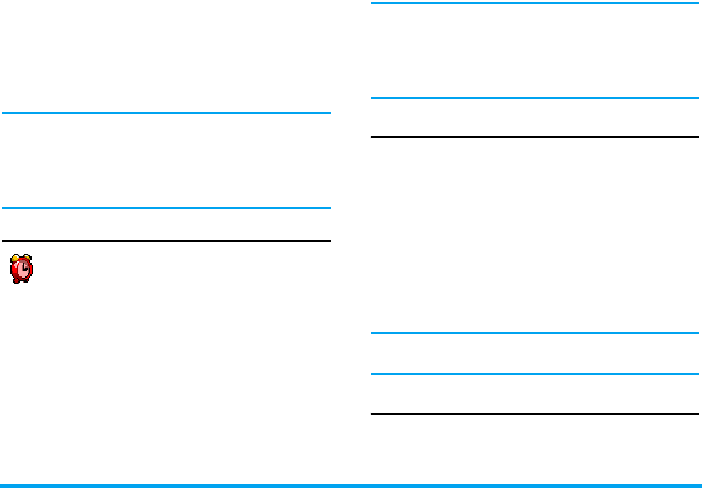
47 Business
When you select a sound file, it is played
automatically in a loop. Press , to access the
options. You can Set a reminder, Play recording,
Rename or Delete it, Send by Email, Infrared or MMS
(see µ⁄25“Š°×Sound album°± for details), Set as
ringer or As SMS/MMS ringer.
A flashing warning sign indicates that your
recording will soon reach the maximum
authorized length. If you do not stop recording, a
red envelope icon informs you that your recording
is too long to be sent via MMS.
Alarm clock
Your mobile phone has a built-in alarm
clock with a snooze feature. You can set up
to three separate alarms and choose whether
or not the alarm should repeat. To set an alarm,
follow the steps below:
1.
Select an alarm and set it On.
2.
Then enter the time and press ,.
3.
Then select the frequency: Once, Daily, On
weekdays.
4.
Finally, select the type of alarm: Melody, Sound
recording, or Buzzer and press ,.
Repeat above steps to set other alarms.
The alarm clock will ring even if your mobile
phone is switched off and/or the ringer volume is
set to Silent. When the alarm rings, press any key to
stop it or close the phone (except if the snooze
mode is on, see below).
Snooze mode
This menu allows you to set the snooze mode On or
Off. When the alarm rings and the snooze mode is
On:
• press any key (except R Stop) to stop the ringing
temporarily or close the phone. The alarm will
ring again around 7 minutes later.
• press R Stop to stop the ringing and the alarm
repetition.
The snooze mode is automatically deactivated after
9 alarm repetitions.
The snooze mode setting applies to all the alarms
you have set.
Firewall
This menu allows you reject all calls and SMS
received from the people you include in the
blacklist.

Business 48
Settings
Select this menu item and press L Select to access
the options described below
Blacklist
This menu displays the list of contacts whose calls
and SMS will be rejected. Select <New> to add a
name and the corresponding number to the list, then
choose whether you want to reject SMS and/or Calls
coming from this person.
Select a name in the list and press , or L Select to
Change the related information or Delete it. Select
Details to display the blacklist details.
You can add a name to the blacklist directly from
phonebook, the Call list and the SMS Inbox: select a
contact, a call or a message in the relevant list,
press
L
Options and simply select Add to blacklist.
The related number will be added to the blacklist.
Auto Switch On / Off
These two separate menus allow you to set your
mobile phone to switch itself on or off at pre-set
times.
To set Auto switch on sound, select the option and
press ,. Select On and press ,. Enter the time at
which you want your mobile phone to switch itself
on and press,. Select the desired frequency from
Once, Daily, or On weekdays and press ,. A
message appears to confirm activation.
Proceed the same way for the Auto switch off sound
option.
Notification To select the way you want to be
notified of a rejected call or SMS:
with a Status icon displayed in idle
screen or an Icon feedback. You can
also choose No notification.
Activation Allows you to set the firewall option
On or Off. When On, your mobile
phone will reject all calls and SMS
received from the people listed in the
blacklist. Rejected calls appear in
the Call list and rejected SMS in the
Spam SMS Box.
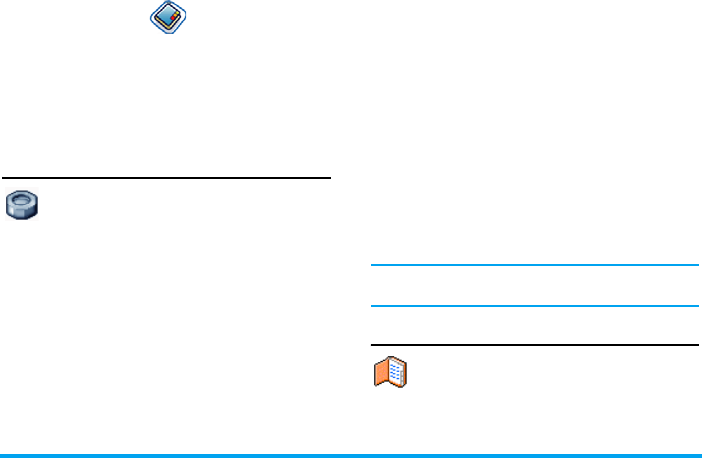
49 Contacts
11 • Contacts
Contacts are stored in one of the two available
phonebooks: in your SIM card (number of entries
depending on capacity) or in your phone (up to 999
names). When entering new names, they will only
be added to the phonebook you have selected.
Settings
This menu contains the settings for
configuring the phonebooks for your
mobile phone.
Delete all
To delete all contacts at once. This option only
applies to the onboard phonebook, not to the SIM
phonebook.
Contacts select
This menu allows you to select the phonebook to
use, either In SIM or In phone. Press + or - to
select a phonebook. Contacts added to the selected
phonebook can then be copied into the other, via the
Copy to SIM or Copy to phone options.
Your mobile phone only manages one phonebook at
a time and will ignore the information relative to the
other one, e.g. if "Smith" is present in both
phonebooks and if you delete it in the phone, it
remains unchanged in the SIM.
Status
Select this menu to display the total number of
contacts you have saved in each phonebook, out of
the total number available.
Copy to phone
This option will copy the content of your SIM card
into your phone. If you cancelled or aborted the
automatic copy of your SIM phonebook when you
first switch on your phone, you can do it manually
with this option.
Selecting this option twice will duplicate all the
names.
Name list
It is in this menu that you can manage the
names, telephone numbers, and e-mail
addresses of your contacts. You can also
access the Names list directly from the home screen
by pressing -.
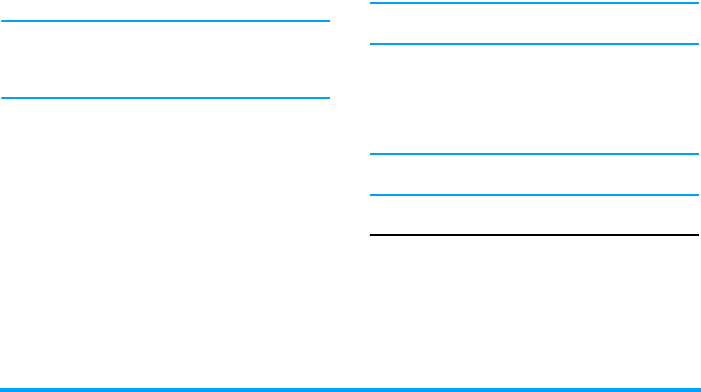
Contacts 50
Adding contacts to the SIM phonebook
1.
Select <New> in the list.
2.
Enter the name and the number of your choice,
then the type of number allocated to the name
(Phone, Fax or Data) and press,to store this
name in your phonebook.
A number is limited to 40 digits, depending on your
SIM card. Entering international prefix, country
and area codes allows you to dial a number from
any location.
Adding contacts in the phone phonebook
1.
Select <New> in the list.
2.
Enter the first, then last name (up to 20 latin
characters); one of the two fields can be empty,
but not both.
3.
Then select the Number type. Numeric fields
can hold up to 40 digits and one "+" sign and
alphanumeric fields (e-mail and note) feature
up to 50 latin characters. Each contact can
feature a maximum of 5 numeric fields (e.g. 2
mobile numbers, 3 work numbers, an e-mail
address and a text note).
If you wish to personalise this contact with a picture
and/or a sound, see below.
Own numbers
The Own numbers item that appears in the contacts
list allows you to store your own phone number. We
advise that you enter your mobile number as well as
any other relevant information.
Although all its fields can be empty, the Own
numbers item cannot be deleted.
Emergency number
The emergency number will call the emergency
services number in your country. In most cases, you
can call this number even if you haven’t yet inserted
a SIM card or entered your PIN.
In Europe the standard emergency number is 112,
in the UK it is 999.
Edit and manage contacts
Press - when in idle mode to access the phonebook.
To search for a given name:
1 to 9
and #
Press the key for the letter that you
want to go to in the list (e.g. press
8 twice to access the letter "U").
The first record starting with this
letter is selected in the list.

51 Contacts
In the SIM phonebook
Choose a contact in your SIM phonebook and press
OK or Options to access the following options:
In the onboard phonebook
Choose a contact of your phone phonebook and
press OK or Options to access the following options:
Select Show to access the list of numbers or fields
saved for this contact. Select <New> to create a new
field or select one of the number and press , to
access a second set of additional options, among
which are:
#Press this key then enter the first
letters of the name you are
searching, and press,to go
directly to that name.
You can also use the <Search>
item appearing in the phonebook.
Call
Call handsfree
Send SMS
Send MMS
Voice dial
Flash dial
Delete
Change
Add to blacklist
Copy to phone
Details
Call handsfree
Send SMS
Send MMS
Send by infrared
Call
Show
Delete
Add to blacklist
Change name
Select picture
Select sound
Make
default
The first number you enter becomes
the default number which is
automatically dialled when pressing
(. This option allows you to set
another default number.
Copy to
SIM card
To copy a contact of your phone
phonebook into the SIM phonebook
(it is then always updated when
switching phonebooks or when using
another phone).
Show To display the details of the selected
field.
Change
type
To change or to define the field type
of the selected number.
Change To change the number of the selected
field.
Voice dial To set a voice tag that will call the
contact when pronounced (see
µ⁄60“Š).
Flash dial To set a direct access to this contact
by linking to a key (see µ⁄61“Š).

Contacts 52
Alphanumeric fields (note and e-mail) can only be
changed or deleted.
Adding picture and sound to contacts
Contacts stored in the phone phonebook can be
personalised with a picture and/or a sound.
This function is only available when you select the
onboard phonebook.
1.
Select a contact and press ,or L Options.
2.
In the list, choose Select picture to add a picture
from the Picture album and choose Select
melody to open the list of ringers and add a
melody.
When the contact calls, the picture and/or sound
associated with this contact will be displayed/
played.
The picture associated with a contact is also used
for the Quickcall feature.When you change it, it is
also updated in the Quickcall settings.
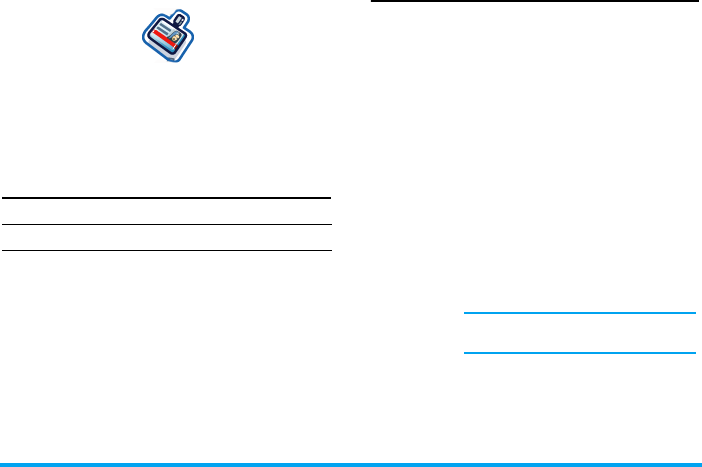
53 Profiles
12 • Profiles
You can set your phone to operate with the
following sound profiles:
Profile selection
To select from different profile:
Personalise settings
Personalise settings includes the following:
•Normal •Headset •USB Cable
• Outdoors • Meeting
Press To
L
Select From main menu, select Profiles.
+
or
-
Navigate to a desired profile.
L
Options Display the Options menu and you
may:
•Activate: Activate the profile.
•Personalise: Customize the profile.
Options Description
Alert type Select the type of alert from Ring
only, Vibrate only, Ring & Vibrate,
Vibrate then ring and None.
Key sound Toggle to turn on/off the key sound.
Ringtones Select ringtone for All calls, All
contacts calls, Alarm, Appointments,
Messages, Cell info and Group 1-10.
Ring
volume
It is a 10-scale volume controller.
Use
+
to increase the volume and
-
to decrease the volume.
Photo
shutter
Select a shutter sound from three
predefined sounds.
This option is only available in
Settings > Sounds.

Connectivity 54
13 • Connectivity
Your phone allows you to connect to a variety of
external devices via infrared, Bluetooth, USB,
CSD, or GPRS. This menu provides you with more
features to set up the connection with these external
devices.
Infrared
You can set up the phone to receive data via infrared
wireless communication, and transfers of files up to
350KB. To use an IR connection, the device with
which you want to establish a connection must be
IrDA compliant. The types of data you can send or
receive include business cards, graphics, images,
sound clips, videos and calendar notes to or from a
compatible phone or data device (for example, a
computer) via the IR port of your phone.
Note that do not expose your eyes directly to the IR
(infrared) beam or allow it to interfere with other IR
devices. This device is a Class 1 Laser product.
Sending and receiving data via IR
Before infrared transmission, make sure you have
the IR ports of the sending and receiving devices
point at each other. Note that there should be no
obstructions between the devices. It is suggested to
keep the two devices at the distance of one meter to
ensure effective connection.
To activate infrared transmission, press Menu >
Connectivity > Infrared. The user of the sending
phone selects the desired IR function to start data
transfer.
Note that if data transfer is not started within two
minutes after the activation of the IR port, the
connection is cancelled and has to be started again.
Bluetooth
Your phone supports Bluetooth wireless
technology, allowing connection to a compatible
Bluetooth device within 10 meters, and transfers of
files up to 350KB. The Bluetooth connection can be
subject to interference from obstructions such as
walls or other electronic devices.
Before you can apply Bluetooth, make sure the
other device supports Bluetooth function by
contacting the device's manufacturer or its
accompanied documentation.

55 Connectivity
Making a Bluetooth connection
To make a Bluetooth connection, enter the main
menu, select Connectivity, then select Bluetooth. On
the Bluetooth screen, select Activate. Next, select
Search for devices. When the list of devices appears,
select one to make a connection with it.
If you do not use the Bluetooth feature for some
time, you should deactivate it in order to conserve
battery power.
Bluetooth menu
When searching for a device, you are presented with
a list of any devices discovered within range of your
Bluetooth-enabled phone. As soon as you select a
device and a connection is made, you are prompted
to enter a passkey in order to pair with the device.
This passkey is supplied by the manufacturer of the
other Bluetooth device, refer to its documentation
for further information. The passkey feature ensures
that only legitimate connections are allowed to
connect either to your device or the selected device.
USB features
This feature allows you to connect your phone to a
PC or a Webcam via USB. To apply the feature:
Options Description
Activate To turn on/off the Bluetooth feature.
Search for
devices
Select to search the external devices
that you connect to your phone.
My devices Select to connect to devices that you
predefined.
Preferences Select to display more features:
• Phone name
• Visible
• Services supported
Press To
L
Select
From main menu, select Connectivity
> USB features.
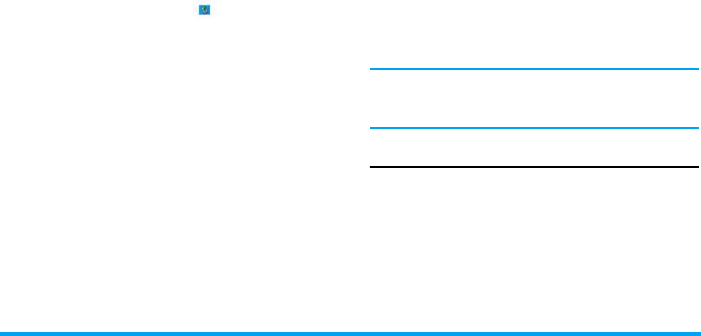
Connectivity 56
When the transfer is finished, please make sure
that you safely remove your device by clicking on
the
Network
This feature allows you to change your Network
settings:
+
or
-
Navigate through USB drive,
Webcam and PC software. Your
mobile phone will then behave such
as a USB drive, a Webcam or will
perform PC connections with
Mobile Phone Tools. If you connect
your phone to PC via PC software,
you can transfer files up to 350KB.
If you connect your phone to PC via
USB drive, you can access your
mini SD card and the transfers file
size is unlimited until your memory
is full.
USB drive This menu allows you to upload and
download music (MP3 and Midi),
videos and pictures via the USB
cable.
Webcam This menu allows you to chat with
your friends via network
conferencing.
PC software It offers an instant sychronization
between your mobile phone and your
computer, and enables you to backup
your mobile phone data on the
computer and recover the data saved
in the computer, upload and
download files, send and receive
SMS and edit your mobile phone
contacts.
L
Select
Select to connect to the desired
device.
Options Description
Select
network
Search for available network.
Search
mode
Select between Automatic and
Manual.

57 Connectivity
Memory card
The phone has a mini-SD memory card slot to
increase the phone’s memory. The phone supports
FAT16 mini-SD cards up to 512MB with
guaranteed performance and quality.
Connections
CSD profiles
This menu allows you to configure a CSD (circuit
switched data) connection to the network. The
available CSD settings are:
GPRS profiles
This menu allows you to configure a GPRS
(General Packet Radio Service) connection to the
network. The available GPRS settings are:
Preferred
networks
Select your preferred network or
press
L
List to change network.
Select band Five bands are available: 900MHz,
1800MHz, 1900MHz, 900/1800MHz
and 900/1900MHz.
Options Description
Name To name the current profile
Call type To toggle between Analogue or
ISDN.
Dial number To enter the dial number of your
WAP service.
Login To enter a login name.
Password To enter the password.
Options Description
Name To name the current profile
APN To enter GPRS APN.
Login To enter a login name.
Password To enter the password.
Authentication To activate/deactivate the feature.

58 Calls
14 • Calls
Most options described in this chapter are operator
and/or subscription dependent and require either a
PIN2 code or a phone code. For more information
on PIN codes, see °×Security°±µ⁄58“Š.
Call history
This menu provides you with a list of calls you have
missed, answered and made. The calls include All
calls, Missed calls, Answered calls and Outgoing calls,
which are displayed in chronological order with the
most recent first. Select a call in one of the lists and
press
L
Options to access the following:
Clear history
This menu allows you to clear the call history: Clear
outgoing/Answered/Missed/All calls. Press
L
Select
to confirm the deletion and
R
Back to cancel the
deletion.
Call settings
This menu allows you to configure call settings:
Options Description
Extract
number
Extract the sender’s phone number
or a number included in the
message itself.
Delete Delete the number from the caller
list.
Call Call the highlighted number.
Call
Handsfree
Call the contact's number in
handsfree mode.
Delete all Delete all the numbers on the lists.
Text
message
Send an SMS to the caller.
Multimedia
message
Send a MMS to the caller.
Options Description
Auto answer Select to turn on/off Auto answer.
Any key
answer
Select to turn on/off Any key
answer.
Minute
reminder
Select to activate or deactivate
Minute reminder and set the Start
time.

Calls 59
Call services This feature allows to you set Time
& cost, Call waiting, Hide ID, Caller
ID and Cost settings. Please refer to
the following Call services menu.
Call services has the following options:
Time & cost: Display the duration
of your calls and their charges: Call
duration, Total incoming, Total
outgoing, Cost left and All voice calls.
Call waiting: Select to activate or
cancel call waiting or Check status.
Hide ID: Withhold for all calls.
Caller ID: Select to display all caller
ID.
Cost settings:The feature
(subscription-dependent) allows you
to manage the costs of your calls by
setting Currency and Personal rate. You
can also select Auto display or set the
Maximum cost.
Call divert Set to divert the following kinds of
calls: All voice calls, If not answered,
If out of reach, When no reply, If
busy, Divert all data calls active,
Check status and Cancel all.
Call barring This menu allows you to limit the
use of your phone to specific calls
by allowing you to prevent the
reception or placing of different
types of calls. The types of calls
you can bar are the following:
• All outgoing
• All international
• Only here & home
• All incoming
• Incoming if abroad
• Check status
• Cancel all
• Phone barring code
Fixed dialling Select to turn on/ off Fix dialling.
Closed user
group
Select to turn on/off Closed user
group, Select group, Outgoing access
and Preferred group.
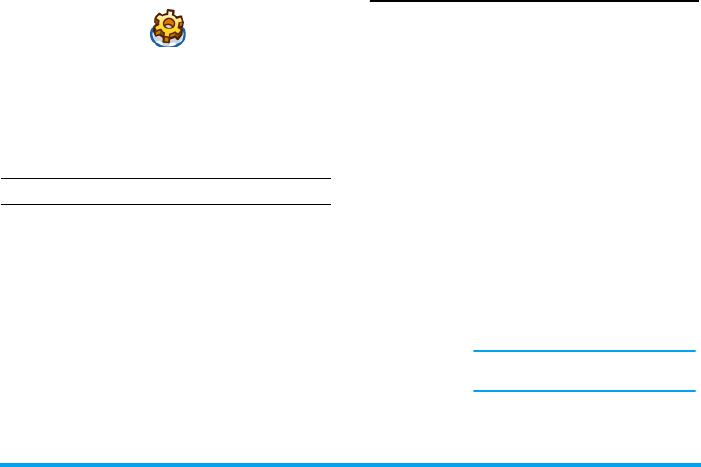
Setting 59
15 • Setting
This chapter describes the contents of the Settings
menu. It is here that you can access the options
(sounds, time and date, security, etc.) to configure
your Philips 568 mobile phone to best suit your
lifestyle.
How to…
General
This menu allows you to configure some general
settings:
Press To
L
Select From main menu, select Settings.
<
or
>
Toggle among four different
Settings menu: General, Display,
Sounds and Connectivity.
+
or
-
Navigate to the desired item under
the four menus.
L
Select Select to confirm the item.
Options Description
Language Select the text entry language and
Display language:
•T9 language: Select to turn on/off
T9 preferred, T9 language and T9
Chinese.
•Phone language: Select form
Automatic, English, Traditional
Chinese and Simplified Chinese.
Time & date For Time & date setting, please
refer to the following Time & date
menu.
Security Select from Change lock code, SIM
lock, Change PIN, Change PIN 2 and
Phone lock.
The default Phone lock code is
123456.

60 Setting
Time & date menu provides the following options:
Record voice command
Voice control You may use voice control to call
up a phone feature or phone
dialing.
•Voice command: Record phone
features for voice command.
•Voice dialling: Record the
contact’s name for voice dialing.
Please refer to the following
description of "Record voice
command"
Auto keypad
lock
Select to activate or deactivate this
feature.
Shortcuts Displays a list of shortcut features.
Default
storage
Define the storage location: Phone
memory or Memory card.
Flight mode Select to turn on/off the airplane
mode.
Default
settings
Restore the phone to default
settings.
Options Description
Display time Select if you want to display the
clock. Toggle between On or Off.
Time zone Use
<
or
>
to select your time
zone.
Set time &
date
Edit your current time and date.
Time Format Set to 12 hours or 24 hours.
Date Format Select a Date Format.
Power-on
time
Select to activate or deactivate this
feature.
Power-off
time
Select to activate or deactivate this
feature.
Countdown Set and use the countdown feature.
Press To
L
Select From main menu, select Settings >
General > Voice Control > Voice
command
+
or
-
Toggle to a desired feature.

Setting 61
Display
You may configure your phone with different
display settings:
Sounds
You can set your phone to operate with five sound
profiles. For details, see "Profiles".
Ringtone setting.
L
Record
> Yes or > No
Start recording (for three times)
Cancel recording.
L
Repeat
or
R
Back
Record again or
cancel recording.
Options Description
Wallpaper Select to turn on/off the wallpaper
display.
Themes Select different Theme types: Simple,
Elegant and Intense.
Backlight
level
Select one level from Maximum,
High, Medium and Low.
Backlight
duration
Select backlight duration from 1
minute, 30 seconds and 15 seconds.
Greetings Select to turn on/off greetings and
edit the greetings message.
Press To
L
Select From main menu, select Settings >
Sounds > Ringtones.
L
Select Select All calls, Alarm, Appointments,
Messages, Cell info or your desired
Groups.
L
Select Select Phone memory or Memory
card.
+
or
-
Navigate the sound files.
L
Select Confirm your desired ringtone.
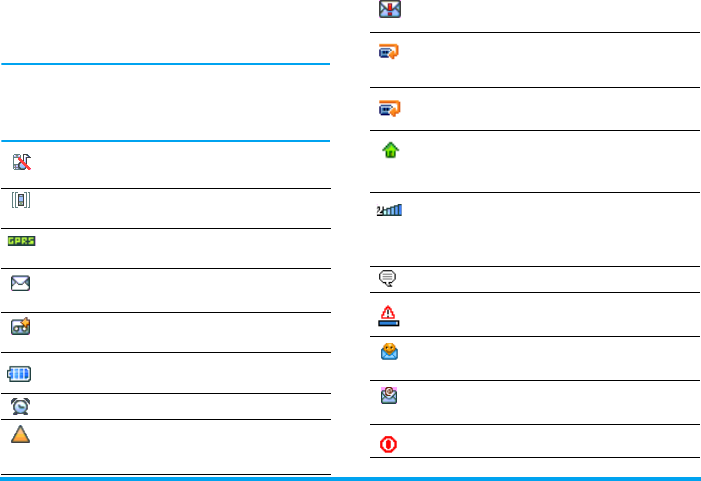
Icons & symbols 62
Icons & symbols
In idle mode, several symbols can be displayed
simultaneously on the main screen.
If the network symbol isn’t displayed, the network
is not currently available. You may be in a bad
reception area, moving to a different location may
help.
Silent
- Your phone will not ring when
receiving a call.
Vibra
- Your phone will vibrate when
receiving a call.
GPRS attach
- Your phone is connected to the
GPRS network.
SMS message
- You have received a new
message.
Voice mail
- You have received a new voice
mail.
Battery
- The bars indicate the battery level
(4 bars = full, 1 bar = low).
Alarm clock
activated.
Roaming
- Displayed when your phone is
registered to a network other than your own
(especially when you’re abroad).
SMS full
- Memory for messages is full. Delete
old messages to receive new ones.
Call Forward Unconditional to number
- All
your incoming voice calls are being
forwarded to a number other than voice mail.
Call Forward to voice mailbox
- All your calls
are being forwarded to voice mail.
Home zone
- A zone designated by your
network operator. Subscription dependent,
contact your service provider for details.
GSM Network
: your phone is connected to a
GSM network.
Reception quality
:
the more bars are shown the
better the reception is.
SMS Chat
- option is set to
On
.
Memory full
- The phone’s memory is full.
Delete items to store new ones.
MMS message
- You have received a new
multimedia message.
Wap message
- You have received a message
in the wap push inbox.
Auto switch on/off
- option is set to
On
.
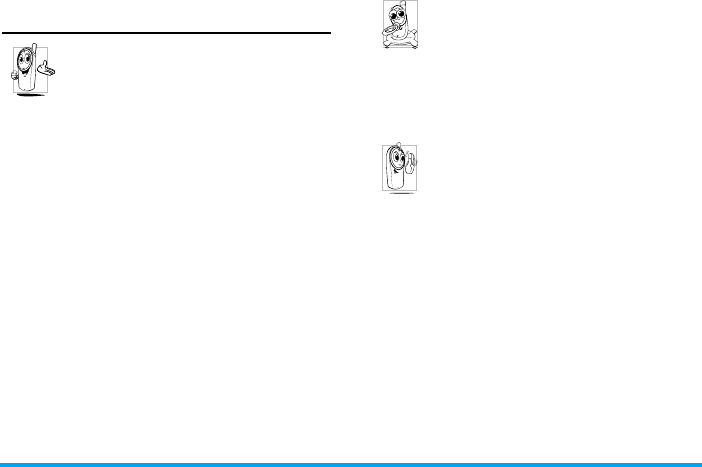
63
Precautions
Radio Waves
Your cellular mobile phone is a low
power radio transmitter and receiver.
When it is operating, it sends and receives
radio waves. The radio waves carry your
voice or data signal to a base station that
is connected to the telephone network. The network
controls the power at which the phone transmits.
• Your phone transmits/receives radio waves in the
GSM frequency (900 / 1800 / 1900 MHz).
• The GSM network controls transmission power
(0.01 to 2 watts).
• Your phone complies with all relevant safety
standards.
• The CE mark on your phone shows compliancy
with European electromagnetic compatibility
(Ref. 89/336/EEC) and low voltage directives
(Ref. 73/23/EEC).
Your cellular mobile phone is your responsibility.
To avoid damage to yourself, to others or to the
phone itself, read and follow all the safety
instructions and make them known to anyone
borrowing your phone. Furthermore to prevent
unauthorised use of your phone:
Keep your phone in a safe place and keep
it out of small children's reach.
Avoid writing down your PIN code. Try to
remember it instead.
Switch off the phone and remove the battery if you
are going to leave it unused for a long time.Change
your PIN code after purchasing the phone and to
activate call restriction options.
The design of your phone complies with
all applicable laws and regulations.
However your phone may cause
interference with other electronic devices.
Consequently you should follow all local
recommendations and regulations when using
your cellular phone both at home and when away.
Regulations on the use of cellular phones in
vehicles and aircraft are particularly stringent.
Public concern has been focused for some time on
the possible health risks for users of cellular phones.
The current research on radio wave technology,
including the GSM technology, has been reviewed
and safety standards have been drawn up to ensure
protection from exposure to radio wave energy.
Your cellular telephone complies with all
applicable safety standards and the Radio
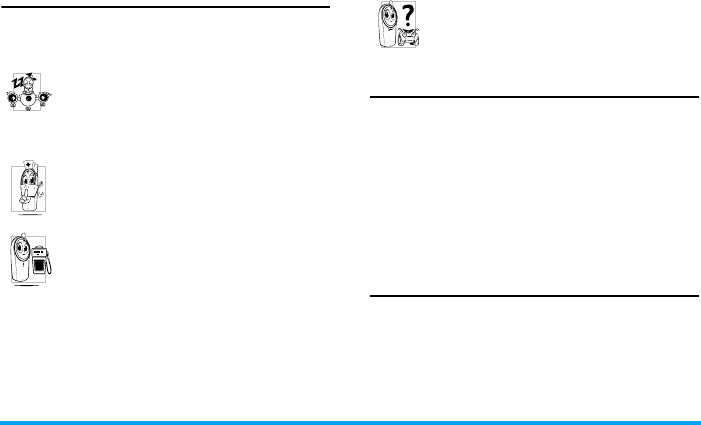
64
Equipment and Telecommunications Terminal
Equipment Directive 1999/5/EC.
Always switch off your phone...
Inadequately protected or sensitive electronic
equipment may be affected by radio energy. This
interference can lead to accidents.
Before boarding an aircraft and/or when
packing the phone in your luggage: the use
of mobile phones in an aircraft may be
dangerous for the operation of the aircraft, disrupt
the mobile phones network and may be illegal.
。
In hospitals, clinics, other health care
centres and anywhere else where you may
be in the close vicinity of medic
al
equ
ipment.
In areas with a potentially explosive
atmosphere (e.g. petrol stations and also
areas where the air contains dust particles,
such as metal powders).
In a vehicle transporting flammable
products (even if the vehicle is parked) or
a vehicle powered by liquefied petroleum gas
(LPG), check first that the vehicle complies with the
applicable safety rules.
In areas where you are requested to turn off radio
transmitting devices, such as quarries or other areas
where blasting operations are in progress.
Check with the vehicle manufacturer that
electronic equipment used in your
vehicle will not be affected by radio
energy.
Pacemakers
If you have a pacemaker:
• Always keep the phone more than 15 cm from
your pacemaker when the phone is switched on,
in order to avoid potential interference.
• Do not carry the phone in a breastpocket.
• Use the ear opposite to the pacemaker to
minimise the potential interference.
• Switch off your phone if you suspect that
interference is taking place.
Hearing aids
If you are a user of a hearing aid, consult your
physician and hearing aid manufacturer to learn
whether your particular device is susceptible to
cellular phone interference.
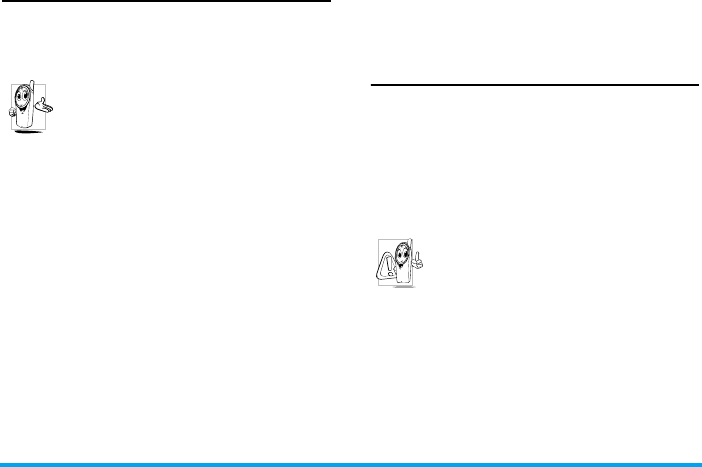
65
Improved performance
In order to improve the performance of your
phone, reduce radio energy emission, reduce
battery consumption and ensure safe operation
adhere to the following guidelines:
For the optimal and satisfactory operation
of the phone you are recommended to use
the phone in the normal operating position
(when not using in hands-free mode or
with a hands-free accessory).
• Do not expose your phone to extreme
temperatures.
• Treat the phone with care. Any misuse will void
the International Guarantee.
• Do not immerse the phone in any liquid; if your
phone is damp, switch it off, remove the battery
and let them dry for 24hrs before using them
again.
• To clean the phone, wipe it with a soft cloth.
• Placing and receiving calls consumes the same
amount of battery energy. However, the mobile
consumes less energy in idle screen when kept in
the same place. When in idle screen and while
you are moving, your phone consumes energy to
transmit updated location information to the
network. Setting the backlight for a shorter period
of time as well as avoiding unnecessary
navigating in the menus will also help to save the
battery’s energy for longer phoning and stand-by
performances.
Battery information
• Your phone is powered by a rechargeable battery.
• Use specified charger only.
• Do not incinerate.
• Do not deform or open the battery.
• Do not allow metal objects (such as keys in your
pocket) to short circuit the battery contacts.
• Avoid exposure to excessive heat (>60° C or
140° F), moisture or caustic environments.
You should only use Philips Authentic
Accessories, as the use of any other
accessories may damage your phone and
will make all guarantees for your Philips
phone null and void.
Make sure damaged parts are replaced immediately
by a qualified technician and that they are replaced
with genuine Philips replacement parts.。
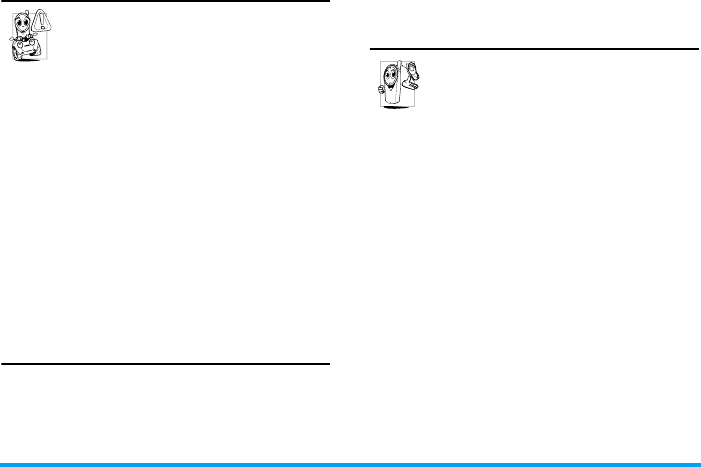
66
Your mobile phone and your car
Studies have shown that speaking on
thetelephone while driving lowers your
concentration, which can be dangerous.
Adhere to the following guidelines:
• Give your full attention to driving. Pull off the
road and park before using the phone.
• Respect the local regulations in countries where
you drive and use your GSM phone.
• If you want to use your phone in a vehicle, install
the hands-free car kit which is designed for that
purpose.
• Ensure that your phone and car kit do not block
any air bags or other security devices fitted in
your car.
• The use of an alarm system to operate a vehicle's
light or horn to indicate incoming phone calls is
prohibited on public roads in some countries.
Check local regulations.
EN 60950 Norm
In hot weather or after prolonged exposure to the
sun (e.g., behind a window or a windscreen), the
temperature of your phone's casing might increase,
especially when featuring a metallic finish. Be very
careful in this case when picking up your phone and
also avoid using it with an ambient temperature over
40° C.
Environmental care
Remember to observe the local regulations
regarding the disposal of the packaging
materials, exhausted batteries and old
phone and please promote their recycling.
Philips has marked the battery and packaging with
standard symbols designed to promote the recycling
and appropriate disposal of your eventual waste
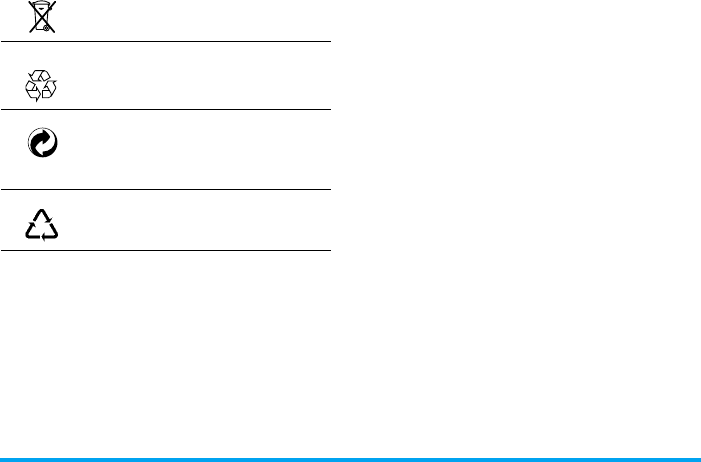
67
The battery should not be disposed
of with general household waste.
The labelled packaging material is
recyclable.
A financial contribution has been
made to the associated national
packaging recovery and recycling
system.
The plastic material is recyclable
(also identifies the type of plastic).

68
Troubleshooting
The phone does not switch on
Remove/reinstall the battery. Then charge the
phone until the battery icon stops scrolling. Unplug
from charger and try to switch the mobile on.
The display shows BLOCKED when you switch
on
Somebody tried to use your phone but didn’t know
the PIN code nor the unblocking code (PUK).
Contact your service provider.
The display shows IMSI failure
This problem is related to your subscription.
Contact your operator.
Your phone doesn’t return to the idle screen
Long press the hangup key or switch off the phone,
check that the SIM card and the battery are installed
correctly and switch it on again.
The network symbol is not displayed
The network connection is lost. Either you are in a
radio shadow (in a tunnel or between tall buildings)
or you are outside the network coverage area. Try
from another place, try to reconnect to the network
(especially when abroad), check that the antenna is
in place if your mobile has an external antenna, or
contact your network operator for assistance/
information.
The display doesn’t respond (or the display responds
slowly) to key presses
The display responds more slowly at very low
temperatures. This is normal and does not affect the
operation of the phone. Take the phone to a warmer
place and try again. In other cases please contact
your phone supplier.
Your battery seems to over heat
You might be using a charger that was not intended
for your phone. Make sure you always use the
Philips authentic accessory shipped with your
phone.
Your phone doesn’t display the phone numbers of
incoming calls
This feature is network and subscription dependent.
If the network doesn’t send the caller’s number, the
phone will display Call 1 or Withheld instead.
Contact your operator for detailed information on
this subject.
You can’t send text messages
Some networks don’t allow message exchanges
with other networks. First check that you entered

69
the number of your SMS centre, or contact your
operator for detailed information on this subject.
You can’t receive and/or store JPEG pictures
A picture may not be accepted by your mobile
phone if it is too large, if its name is too long, or if
it doesn’t have the correct file format.
You have the feeling that you miss some calls
Check your call divert options.
During battery charge, the battery icon shows no bar
and the outline is flashing
Only charge the battery in an environment where
the temperature does not go below 0°C (32°F) or
above 50°C (113°F).
In other cases please contact your phone supplier.
The display shows SIM failure
Check that the SIM card has been inserted in the
right position. If the problem remains, your SIM
card may be damaged. Contact your operator.
When attempting to use a feature in the menu, the
mobile displays NOT ALLOWED
Some features are network dependent. They are
only available, therefore, if the network or your
subscription supports them. Contact your operator
for detailed information on this subject.
The display shows INSERT YOUR SIM CARD
Check that the SIM card has been inserted in the
right position. If the problem remains, your SIM
card might be damaged. Contact your operator.
The autonomy of your phone seems lower that
indicated in the user guide
The autonomy is linked to your settings (e.g., ringer
volume, backlight duration) and the features you
use. To increase the autonomy, and whenever
possible, you must deactivate features you do not
use.
Your phone doesn’t work well in your car
A car contains many metallic parts that absorb
electromagnetic waves which can affect the phone’s
performances. A car kit is available to provide you
with an external antenna and enables you to make
and receive phone calls without handling the
handset.
Check with local authorities if you are allowed to
use the phone whilst driving.
Your phone is not charging
If your battery is completely flat, it might take
several minutes of pre-charge (up to 5 minutes in
some cases) before the charging icon is displayed on
the screen.
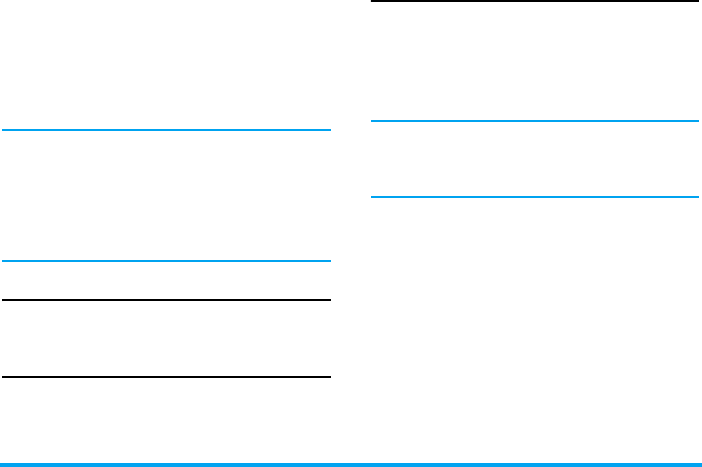
70 Philips Authentic Accessories
Philips Authentic
Accessories
Some accessories, such as a battery and a charger,
are included as standard in the package of your
mobile phone. Additional accessories may also be
provided or sold separately. Package contents may
therefore vary.
To maximise the performance of your Philips
mobile phone and not to void the warranty, always
purchase Philips Authentic Accessories that are
specially designed for use with your phone. Philips
Consumer Electronics cannot be held liable for
any damage due to use with non authorised
accessories.
Charger
Charges your battery in any AC outlet. Small
enough to carry in a briefcase/handbag.
Carry case
Protects your phone from nicks and scratches.
Data connect kit
Provides easy data connection to your Philips
mobile phone. The USB cable enables high speed
communication between your phone and your
computer. The provided software allows you to
download pictures and melodies and to synchronise
your contacts and appointments.
When your mobile phone is connected to the PC
via a USB data cable, the cable also acts as
charger to charge your phone (9@9m USB
charging compatible with most PCs).

71
Trademark declaration
JAVA is a trademark of Sun
Microsystems, Inc.
T9® is a trademark of Tegic
Communications Inc.
In-Fusio and the games
engine Exen are trademarks
of In-Fusio France.
Tegic Euro. Pat.
App. 0842463

72
Limited warranty
1. What Does This Limited Warranty Cover?
Philips warrants to the original retail purchaser
(“Consumer” or “You”) that this Philips
cellular product and all accessories originally
provided by Philips in the sales package
(“Product”) are free from defects in materials,
design and workmanship under normal use in
accordance with the operating instructions and
pursuant to the following terms and conditions.
This limited warranty extends only to the
Consumer for Products purchased and used in
the original country of purchase. The limited
warranty is valid only in Philips’ intended
country of sales of the product.
2. How Long is The Limited Warranty Period?
The limited warranty period for the Product
extends for ONE (1) YEAR from the date of
purchase of the Product, documented by valid
proof of purchase. The limited warranty for
original Philips rechargeable battery extends
for six (6) months from the date of purchase.
3. What Will Philips Do if The Product is Not
Free From Material Defects in Materials and
Workmanship During The Limited Warranty
Period?
During the limited warranty period, Philips or
its authorized service representative will, at its
option either repair or replace, without charge
for parts or labour, a materially defective
Product with new or refurbished parts or
Product and return such repaired or replaced
Product to the Consumer in working condition.
Philips will retain defective parts, modules or
equipment.
Repaired or replaced Product will be covered
by this limited warranty for the balance of the
original limited warranty period or ninety (90)
days from the date of repair or replacement
whichever is longer. Repair or replacement of
Product, at Philips’ option is your exclusive
remedy.
4. What is Not Covered By This Limited
Warranty?

73
This limited warranty does not cover:
a) Product that has been subjected to misuse,
accident, shipping or other physical
damage, improper installation, abnormal
operation handling, neglect, inundation,
fire, water or other liquid intrusion; or
b) Product that has been damaged due to
repair, alteration, or modification by
anyone not authorized by Philips; or
c) Product that has reception or operation
problems caused by signal conditions,
network reliability or cable or antenna
systems; or
d) Product defects or problems caused by
uses with non-Philips products or
accessories; or
e) Product which warranty/quality stickers,
product serial number or electronic serial
number has been removed, altered or
rendered illegible; or
f) Product purchased, used, serviced, or
shipped for repair from outside the original
country of purchase, or used for
commercial or institutional purposes
(including but not limited to Products used
for rental purposes); or
g) Product returned without valid proof of
purchase or which proof of purchase has
been altered or is illegible.
h) Normal wear and tear or Force Majeure.
5. How Do You Get Warranty Service?
a) Return the Product to an authorized service
center of Philips. You may contact the
local Philips office for the location of the
nearest authorized service center.
b) The SIM card must be removed from the
Product before it is given to Philips. Philips
assumes no liability for damaged or loss of
the SIM card or the data contained therein.
c) If the Product failure is not covered by this
limited warranty, or this limited warranty
is inapplicable, void or invalid due to any
terms and conditions stated herein, the
Consumer will be charged for the cost of
repair or replacement of the Product and all
other related cost incurred in repairing or
replacing the Product.
d) IMPORTANT - you are required to return
the Product together with a valid proof of
purchase which must identify the point of
purchase, date of purchase, Product model
and Product serial number clearly.

74
6. Other Limitation: This Warranty is The Entire
Agreement.
EXCEPT FOR THE EXPRESS
WARRANTIES SET FORTH ABOVE AND
THOSE IMPLIED BY LAW AND WHICH
CANNOT BE EXCLUDED OR MODIFIED
BY AGREEMENT, PHILIPS PROVIDES NO
OTHER WARRANTY WHETHER
EXPRESS OR IMPLIED (WHETHER BY
STATUTE, UNDER THE OPERATION OF
LAW OR OTHERWISE) AND SPECIALLY
DISCLAIMS ANY WARRANTY OF
SATISFACTORY QUALITY
MERCHANTABILITY OR FITNESS FOR A
PARTICULAR PURPOSE.
PHILIPS’ TOTAL LIABILITY FOR
DAMAGES RELATING TO OR ARISING
OUT OF THE PURCHASE OR USE OF THE
PRODUCT, REGARDLESS OF THE TYPE
OR CAUSE OF SUCH DAMAGE OR THE
FORM OR CHARACTERISATION OF THE
CLAIM ASSERTED (E.G. CONTRACT OR
TOPIT), SHALL NOT EXCEED THE
ORIGINAL PURCHASE PRICE PAID FOR
THE PRODUCT.
HOWEVER IN NO EVENT SHALL PHILIPS
BE LIABLE FOR ANY PUNITIVE,
SPECIAL, INCIDENTAL, INDIRECT OR
CONSEQUENTIAL DAMAGES (INCLUDING
BUT NOT LIMITED TO THE LOSS OF USE,
LOSS OF TIME, INCONVENIENCE,
COMMERIAL LOSS, LOST PROFITS,
LOST BUSINESS OPPORTUNITIES, COST
OF SUBSTITUTION OF GOODS OR
SERVICES, INVESTMENTS, DAMAGE TO
GOODWILL OR REPUTATION, OR LOSS
OF DATA AND CLAIMS BY THIRD
PARTIES) RESULTING FROM PURCHASE
OR USE OF THE PRODUCT, TO THE
FULLEST EXTENT ALLOWED BY LAW,
WHETHER OR NOT PHILIPS HAS BEEN
ADVISED OF THE POSSIBILTY OF SUCH
DAMAGES. THESE LIMITATIONS SHALL
APPLY NOTWITHSTANDING THE
FAILURE OF THE ESSENTIAL PURPOSE
OF ANY LIMITED REMEDY.
This limited warranty represents the complete
and exclusive agreement between the
Consumer and Philips with respect to this
cellular Product and it supercedes all prior
agreements between the parties, oral or written,
and all other communications between the
parties relating to the subject matter of this
limited warranty. No carrier, retailer, agent,
dealer, employee, thereof, or employee of
Philips is authorized to make modifications to

75
this limited warranty and you should not rely on
any such representation.
This limited warranty does not affect the
Consumer’s statutory rights under applicable
national laws in force.
SAR INFORMATION
The SAR limit of USA (FCC) is 1.6
W/kg averaged over one gram of
tissue. Device types Xenium 9@9m
(FCC ID: T38CT9A9M) has also
been tested against this SAR limit.
The highest SAR value reported
under this standard during product
certification for use at the head is
0.331 W/kg and when properly worn
on the body is 0.351 W/kg. This
device was tested for typical
body-worn operations with the back
of the handset kept 1.5cm from the
body. To maintain compliance with
FCC RF exposure requirements, use
accessories that maintain a 1.5cm
separation distance between the
user's body and the back of the
handset. The use of belt clips,
holsters and similar accessories
should not contain metallic
components in its assembly. The use
of accessories that do not satisfy
these requirements may not comply
with FCC RF exposure requirements,
and should be avoided.
Cautions
Any changes or modifications to your
phone not expressly approved in this
document could void your warranty
for this equipment and void your
authority to operate this equipment.
Only use approved batteries,
antennas and chargers. The use of
any unauthorized accessories may
be dangerous and voids the phone
warranty if said accessories cause
damage or defect to the phone.
Although your phone is quite sturdy,
it is a complex piece of equipment
and can be broken. Avoid dropping,
hitting, bending or sitting on it.
1.1 FCC declaration of
conformity for Section 15.105
NOTE: This equipment has been
tested and found to comply with
the limits for a Class B digital
device, pursuant to part 15 of the
FCC Rules. These limits are
designed to provide reasonable
protection against harmful
interference in a residential
installation. This equipment
generates, uses and can radiate
radio frequency energy and, if not
installed and used in accordance
with the instructions, may cause
harmful interference to radio
communications. However, there
is no guarantee that interference
will not occur in a particular
installation. If this equipment does
cause harmful interference to
radio or television reception, which
can be determined by turning the
equipment off and on, the user is
encouraged to try to correct the
interference by one or more of the
following measures:
— Reorient or relocate the receiving
antenna.
— Increase the separation between
the equipment and receiver.
— Connect the equipment into an
outlet on a circuit different from that
to which the receiver is connected.
— Consult the dealer or an
experienced radio/ TV technician for
help.
This device complies with part 15 of
the FCC Rules. Operation is subject
to the following two conditions:
(1) This device may not cause
harmful interference, and
(2) this device must accept any
interference received, including
interference that may cause
undesired operation.